Tenra Bansho Zero by Doresh
| 1 | Tools of the Trade |
| 2 | Untitled Post |
| 3 | Armour |
| 4 | Onmyojutsu |
| 5 | Samurai |
| 6 | Buddhism |
| 7 | Kijin |
| 8 | Kongohki |
| 9 | Ninja |
| 10 | Kugutsu |
| 11 | Annelidists |
| 12 | Oni |
| 13 | Shinto Agents |
| 14 | Ayakashi |
| 15 | Arts of War |
| 16 | Within the Shadows of Tenra |
| 17 | Against the Tide |
Tools of the Trade
Original SA post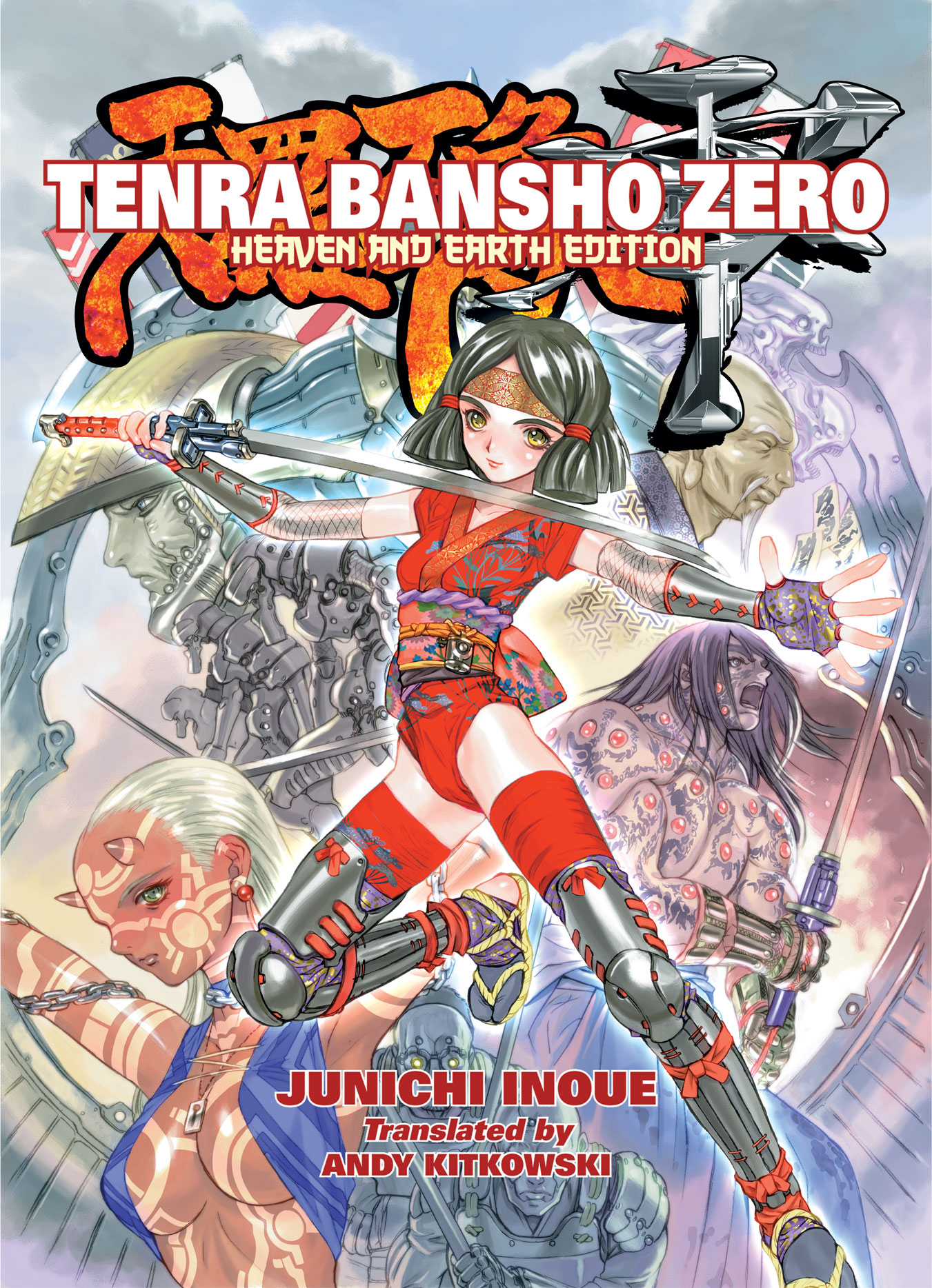
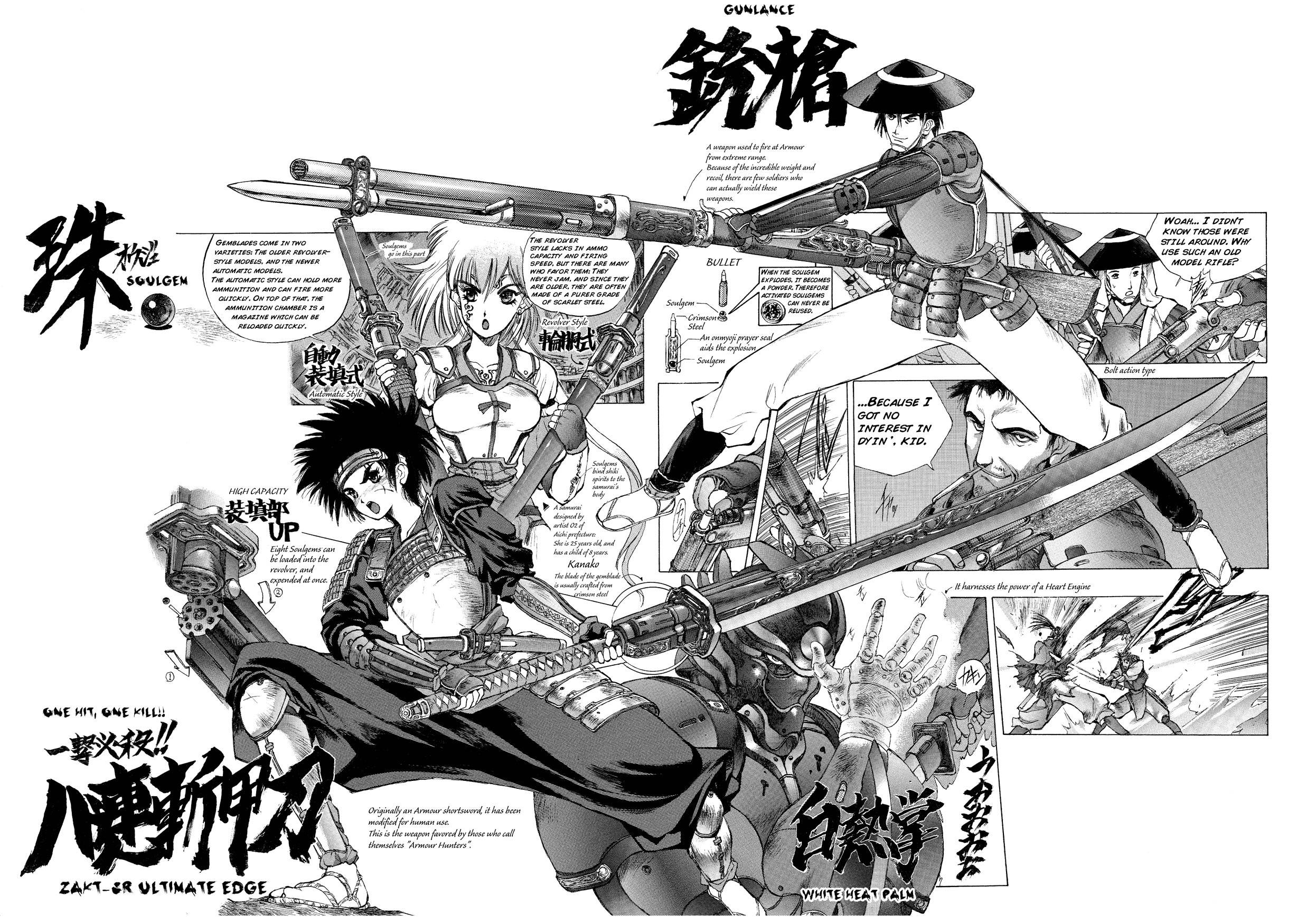
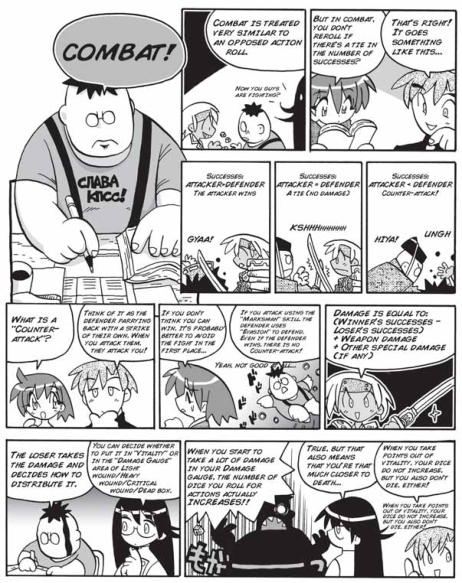
Untitled Post
Original SA post Tenra Bansho Zero
I'll summarize the next 3 chapters, as they are mainly about general roleplaying and scenario creation guidelines. This will be a quick look at what TBZ does differently.
Session Structure
TBZ divides each Session into around 3-4 Acts, similar to a stage play (like in kabuki theater). And just like in a stage play, Acts can potentially be years apart.
Acts are further divided into Scenes , which usually only last a few minutes and end as soon as the location changes or enough time has passed.
After each Act, you have an Intermission for bookkeeping purposes. This is where Fates are changed and Karma is managed. This is also the time you can say goodbye to your PC if he ends the Intermission with over 108 Karma and turns into an Asura , someone so obsessed with his earthly attachment that he essentially turns into a deranged Batman villain.
And here comes a big quirk of TBZ: You know how you generally want to keep the party together most of the time? Not so in TBZ. It is not uncommon to roleplay through several Scenes where the party is never complete.
How does this work out? Well for starters, the players whose characters are currently "off-screen" essentially play the audience, handing out Aiki chits for good performances. If you'd rather want to enter the Scene yourself, you can spend a point of Kiai to invite yourself in. But the most interesting part involves the GM handing out Aiki chits for players to join the scene - by taking the role of a NPC.
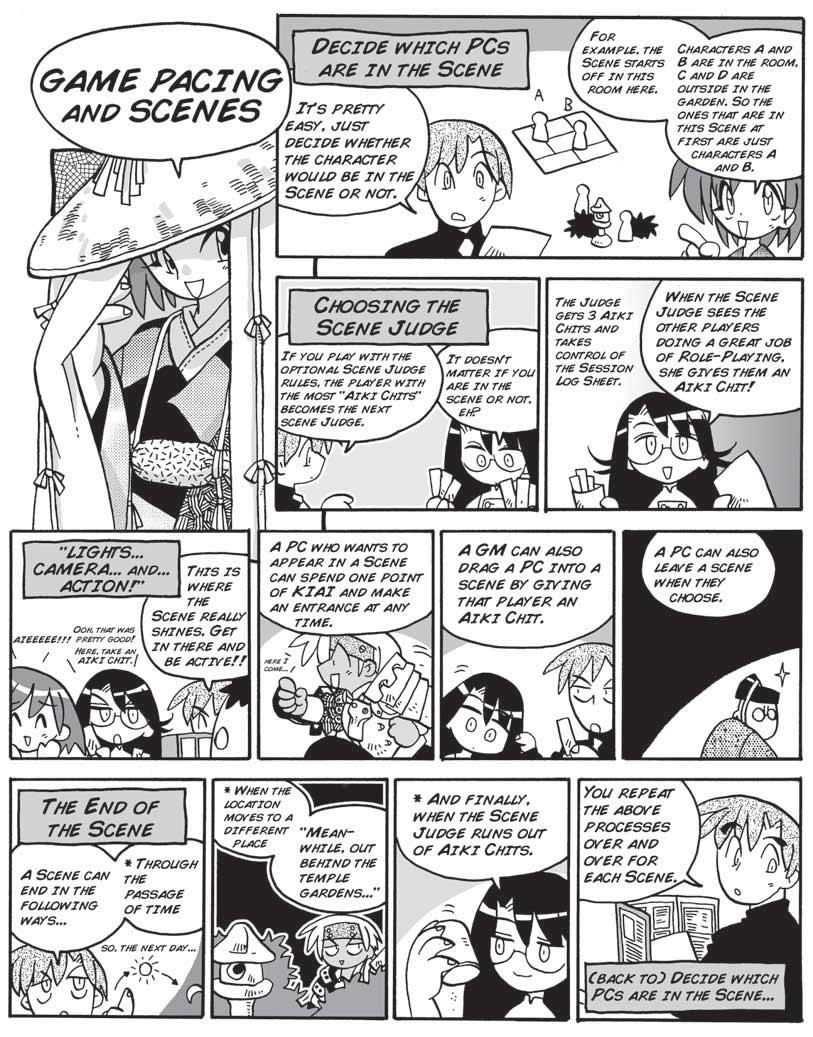
I think that's actually a pretty neat idea. It makes the GM's work a bit easier, results in more interesting roleplaying sessions because the players aren't just talking with the same dude, and it gives the players a chance to take on a wildly different role to earn some more of those Aiki chits.
(Of course, the GM always jank away control from a NPC if the player does something silly, like showering the party with treasure for no reason or something.)
The Emotion Matrix
This is a 6x6 grid used to randomly determine a PCs initial emotionally reaction towards a new NPC, and it can also be used to come up with Fates.
If you are unhappy about the Emotion Matrix result, you can spend Kiai to move around on the grid. The GM and other players can also bribe you with Aiki chits to move where they want you to be.
Naturally, you generally want to change the result if it appears a bit weird, like if the group meets a nice princess and one PC suddenly has his danger sense on overdrive (which is one of the examples presented in the book).
Zero Act
This is the first Act of the game, where each Scene serves to introduce the PCs one by one (usually in the form of a backstory). This is also where each PC gains a Destiny , a Fate set by the GM that serves as that character's overall goal of the scenario. The Emotion Matrix is also used in this Act to find out how the PCs initially feel about each other.
The Moment of Truth
This is an optional rule that allows a PC to essentially call out a last stand once per game. It allows the entire group to pump the PC full of any Aiki chits they're willing to hand out. The PC then converts all of it into Kiai to overcome whatever danger he is facing - and he hopefully can get rid of all the amassed Karma in the next Intermission.
NPCs
NPCs in TBZ can be created as detailled or as simplified as the GM sees fit. They don't have to follow the character creation rules. Simple mooks have very low stats, extremely few Vitality Points and no Wound Boxes to speak of. Major villains and bosses can have ridiculously inflated stats the PCs can never hope of reaching themselves.
Asura
These are the most evil and insane NPCs the group can come across, and they can end up becoming ones themselves. It should be noted that Asuras are relatively rare and that the GM shouldn't overuse them.
The thing that really makes Asuras dangerous is that they have Kiai like PCs - and the only thing worse than a boss with inflated stats is a boss with inflated stats who can just grant himself extra actions. Thankfully, Asuras cannot gain new Kiai and have to make due with their starting pool.
The Campaign Game
In typical Japanese tabletop tradition, TBZ isn't really meant for long-term campaigns. Each Scenario is usually a self-contained story, though old characters can still appear in new stories.
The two recommended ways to play an actual campaign involve playing out an epic war chronicle that can span decades (think Romance of the Three Kingdoms), or do the typical murder hobo routine of "group travels around and performs various murder hobo missions".
Next Time : Armour - become the gemblade that smites evil.
Armour
Original SA post Tenra Bansho Zero
Let's cover some (not so) giant robots, shall we?
Armour
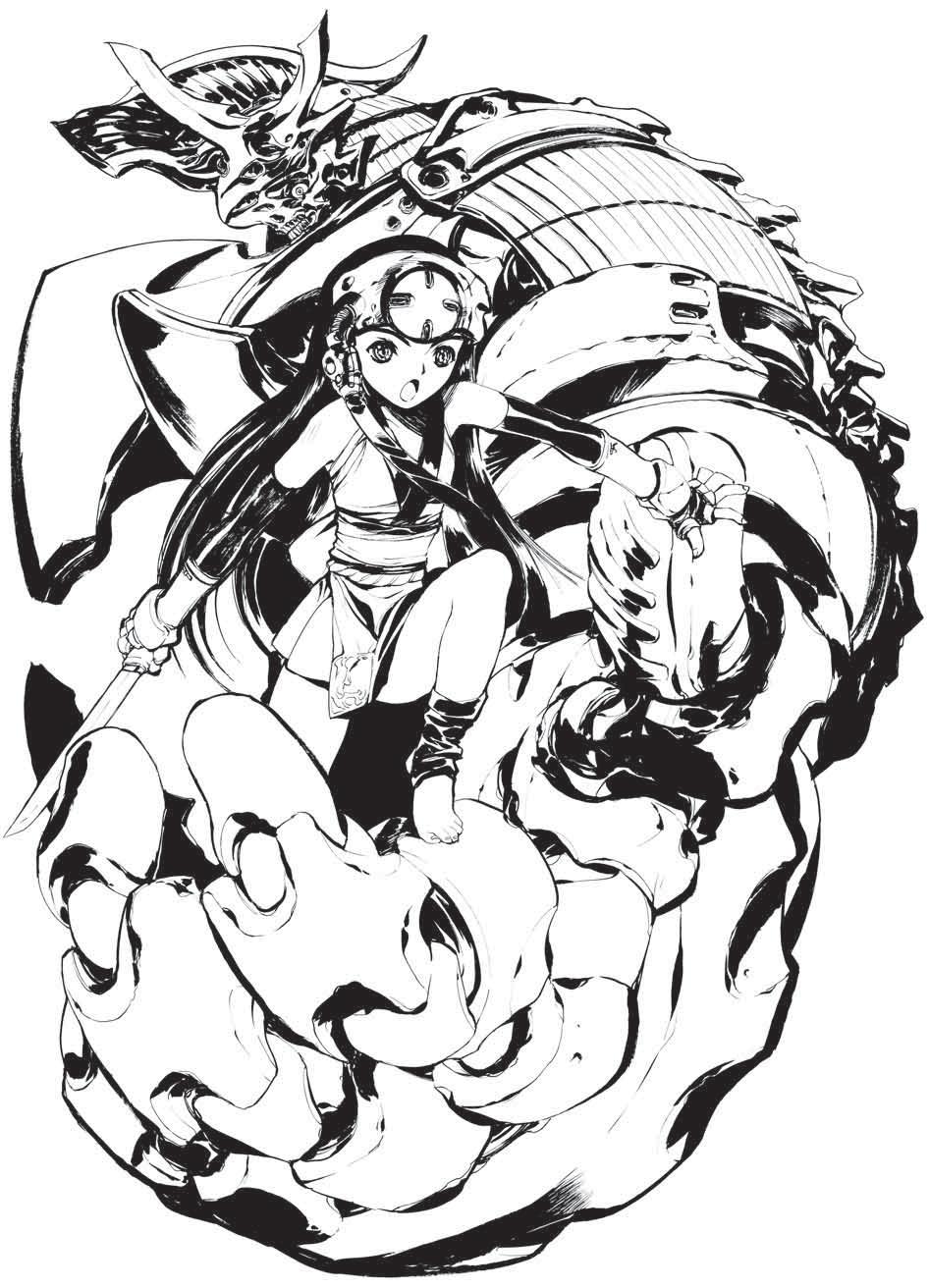
Say hello to my little friend.
Armours are the stars of any battlefield. Their sheer firepower makes them a force to behold, and their size and appearance makes them both a terrifying foe to fight and a giant humanoid banner to rally the own troops. Waging a war withou sufficient Armours is foolish, and a lord can measure his wealth and power (as well as their standing with the Shinto priesthood before the schism) by how many Armours he has under his command.
Technical Stuff
Armours are for the most part pretty small compared to your typical Japanese mecha and much closer to something you find in Heavy Gear (probably so their pilots can better interact with the non-mecha PCs). There are no hard numbers presented, but Armours are somewhat over twice as tall as an average human.
Building an Armour requires plenty of Scarlet Steel and Onmyojutsu-infused magitek muscles to allow for movement. Power for said movement is provided the with a Heart Engine, which is not only an infinite source of energy, but also the only real energy generator on Tenra aside from windmills (if you count them) and whatever secret pre-colonization stuff the Shinto priesthood as stashed in its basements.
Armour cockpits are very streamlined in that the only kind of control interface used is either a meikyo or kimenkyo mirror. The pilot - called an Armour Rider plugs his special interface helm into the mirror and can then control the Armour like his own body.
Meikyo Armour
The oldest and most powerful kind of Armour. Easily recognized by their armour- or lifelike appearance and lavish decorations, with at least one of its weapons being heavily customized or a unique creation. It is not uncommon for a meikyo Armour to be a sort of family heirloom, being passed down from one generation to the next.
The unique trait of meikyo mirrors is that they transfer the Rider's soul into themselves while he is interfaced, absorbing the Karma generated by him to improve the Armour's power and reaction time. The unfortunate side-effect of this is that too much Karma makes it very easy for the Rider to turn into an Asura (they instantly become one as soon as they have over 108 Karma, whereas everyone else can just wait till the end of the next Intermission to get that number down). Becoming an Asura while interfaced is especially nasty, as the Rider's soul is now forever trapped inside the mirror and the Armour becomes his de facto body.
As a security measure against such an event, meikyo mirrors will reject anyone who is burdened by too much Karma. And just to make sure, the mirror will never accept that Rider ever again.
It is for this reason that meikyo armours are not piloted by a noble lord and his retainers, but by their underaged children, for only they are innocent and sheltered enough to have an insignificant amount of Karma. Still, gaining Karma is part of human life (especially when you're killing people by the hundreds as a giant death machine), and most Riders don't even get past their teenager phase before the mirror rejects them.
(If your going by the the artwork, pretty much all meikyo Riders are girls. I guess the boys are busy taking bushido lessons or something.)
Before the schism, it was normal for these teenagers to just move on with their life. But now, a new kind of Armour has been born.
Kimen Armour
When the Northern Court made the knowledge of meikyo creation public, it quickly turned out that they apparently held back a lot of secrets. Though these new kimenkyo mirrors may be inferior to their meikyo ocunterpart, they are nevertheless easier to come by and faster to produce.
With these kimenkyo came the kimenkyo Armours (abbreviated as Kimen Armour), who like the mirrors controlling them are much more mechanical, functionally-designed knockoffs of the meikyo Armours. Still, any shortages in direct power are easily countered by mass-producing Kimen Armours. As a result, the traditionalistic Southern Court was forced to crank up their meikyo mirror production to keep their loyal lords competitive.
With none of the soul-sucking Karma shenanigans of their meikyo counterparts, Kimen Armour readily accept any Rider. Noble Armour Riders that have been rejected by their family's meikyo Armour are now able to continue their service, and the huge influx of Armours has led to the recruitment of Rider candidates with a lower social status.
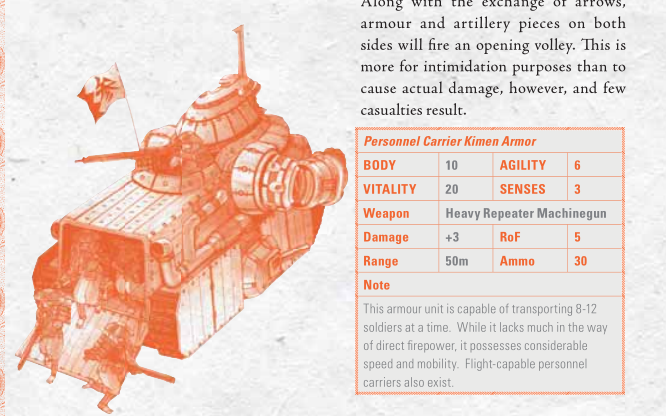
All onboard the Armour train!
Armours are not only more numerous than they have ever been, but Kimen Armour smiths are also broadening the combat roles of the Armour, like Armour with wheels or tank threads to break through entrenchments or even pure support Armour that is essentially an APC with a humanoid torso.
Since the Northern Court also lifted an old ban on high altitude flight, Armour smiths have begun to tinker with flight systems in order to challenge the shikigami's air superiority role. Still the Southern Court still uses the ban, and flying to close to their HQ has a good chance of you vanishing forever.
Another neat benefit of the Kimen Armour is the greater availability of replacement parts. The standardized and modular design of Kimen Armour even makes it possible to perform extensive reconfigurations between missions.
Armour Frames
Aside from the general meikyo/kimenkyo divide, there exists a couple sub-types (or frames) aside from the standard Armour:
Suit Armours originally started as experiments to create wearable Kongohki (a first hint at their nature) that didn't quite work out. The advent of the Kimen Armour has created new interest in Suit Armour, as they make for some pretty cheap shock troopers. Overall, they are less rad Kongohki that can still have a social life.
(I have a suspicion that Suit Armours were a rather late addition to the game. They have no artwork related to them, and they are the only kind of Armour that doesn't even get a passing mention in the settings book.)
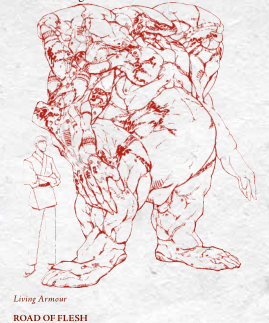
Icky.
Living Armours combine annelid (aka super monster parasites) knowledge with normal Armour smith know-how to create an Armour whose outer layer is largely composed of living tissue. This gives the armor a pretty gross and monstrous appearance, but allows for some nice annelid powers, like gaining regeneration or being able to hulk out.
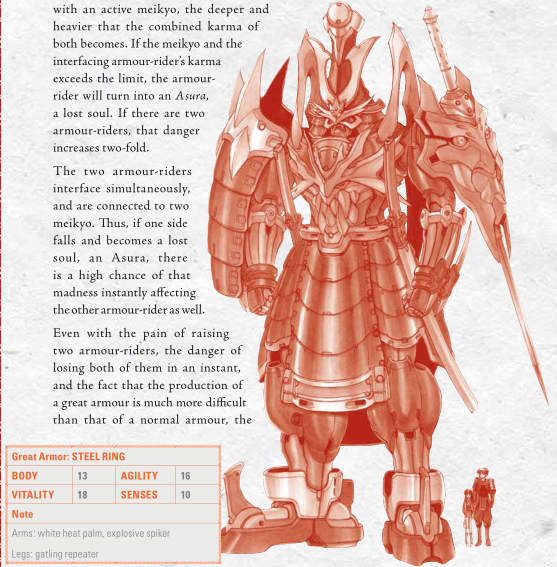
Clearly not overcompensating for anything.
Great Armours are the pinnacle of Armour design, being much more taller than any other Armour and requiring two Riders (usually a driver and a gunner), each with their own mirror (one of which must be a meikyo). Despite their truly fearsome power, Great Armour are rarely used because the dangers to the two Riders are multiplied, as only one of them needs to become an Asura for the other to become one as well. Armour with even more Riders are even rarer for this reason.
Only mentioned, but not codified with rules are transformable and combinable Armours.
Rules
Armours only have physical Attributes (Body, Agility and Sense) which replace the Rider's when he interfaces. Interfacing also causes all physical skill checks to use the Rider's Interface skill - except when he's using an Art of War skill (aka martial arts style).
Since Vitality and Wound Track are usually determined with Body + Will, Armours only use Body.
By default, the only extra sense an Armour has is the so-called Lifepulse , a kind of sonar for living beings.
Meikyo Armour Riders will have the grand majority of their starting Karma be stored inside their meikyo mirror, who will gobble up any Karma he generates while interfaced. The amount of stored Karma is used to calculate the meikyo bonus , which are bonus dice added to any physical Armour roll (going from +0 to +6, though PCs will have to make do with a max. bonus of +5 because +6 is Asura-only territory). As noted above, interfaced Armour Riders can't go above 108 Karma during a Scene and get rid of the excess Karma during the Intermission. They immediately go Asura.
Even with the juicy meikyo bonus, a Rider eventually has to somehow get some Karma off his meikyo mirror. To do this, he can either hire a Buddhist monk to berform a cleansing ritual, or draw some of the Karma into himself by raising one of his Fates during an Intermission.
Armour Creation
After picking the Armour's Frame - which determines amount of Attribtue points to spend and the required Station of the Rider (the latter behing much lower on a kimenkyo model), it is time to decide the overall design of the Armour. You'll then have several slots to spend on special Armour equipment, built-in weapons and upscaled mechanica (aka cybernetics). Armours can also wield upscaled weapons from the general weapon list (who get a nice damage bonus in the case of melee weapons) as long as they have slots to store them in.
While Armour designs can greaty vary from the standard humanoid form, doing so makes it harder to pilot as the Rider has to adapt to this strange form. This is represented by giving non-humanoid designs worse or at least less balanced Attribute modifiers.
Head Gear
The first cutomization step is purely cosmetical and involves picking a face and helmet type. The face can be either humanoid (be it demonic, very human-like or your typical mecha affair) or a skull (if you're a fan of Rifts or BattleTech). The helmet can be either a classic samurai kabuto , or a fabulous plume helmet . If you're familiar with Super Robot Wars, this means you get to pick between the Daizengar or the Aussenseiter .
Unsurprisingly, slots in the head region go into improved or additional senses like night vision, motion detection and the Sha Sensor for Onmyojutsu Riders. Also handy are the Eyes of Distant Death , an aptly-named targeting aid system for ranged weapons. No rules for Gundam-style vulcans, but it should be possible to just mount a repeater on a head slot.
Upper Torso and Arms
Each Armour has to have at least 2 arms (probably so any Armour can wield weapons). Other than that, you can have as many pairs as you require slots. Additional arm pairs result in a negative modifier to Body and Senses, but they improve your Agility.
Slots in this region offer a variety of specialized equipment. The Backpersonnel Transport turns your Armour in an APC to carry soldiers around, and you even get a free infantry-scale weapon with it. Heaven's Fire are jump jets, and Rotor Blades as well as Thruster Wings give you different flavors of flight.
If you're paranoid about your Armour falling into enemy hands, you can install a self-destruct device with the Brilliant Flower of Destruction .
Lower Torso and Legs
Aside from your typical two-legged form, you can take no legs to make a tank or snake robot. This option has the worst Attribute modifiers and the fewest slots, but it replaces the standard Unarmed Attack with a Rolling/Crushing attack that scales nicely with Body.
Four legs give you a centaur robot with doubled movement speed and the most torso slots of them all. With six or more legs , you can make a crustacean, instectoid or arachnoid Armour with lots and lots of leg slots.
Aside from a more spacious APC section than the upper torso, there are a variety of movement boosters whose choice depends on the amount of legs used: any legged Armour can take Heaven Roller Legs to replace their legs with large wheels for quadrupled movement speed and a bonus to evasion. Armour with 2 or 4 legs can instead choose to get themselves rollerskates in the form of the Gale Speed Rollers that only work on flate surfaces. 4 or more legs allow the installation of Hover Replacements for double movement rates and of course some nice hover ability. 0 to 2 legs allow you to take the Legs of the Water Dragon for underwater operations.
Armour Weapons
Aside from wielding oversized normal weapons, Armours can have a variety of built-in weapons, most of which are only allowed to be installed in one or two locations.
Melee weapons naturally go into the arms or legs:
-
Explosive Spiker
: A gunpowder-enhanced spear attached to the arm or leg. To continue the SRW analogues, this allows you to be the
Alt Eisen
.
-
Twin Blades
: Double-bladed arm or leg blades that are also gemblades according to their ROF.
-
Vajra Claws
: Pretty rad Freddy-Krueger-style claws for your hands or feet. Also gemblades.
-
White Heat Palm
: Your Shining Finger (or Shining Toe) attack. You can boost the damage by spending Soul, though Armour-scale White Heat Palms are very inefficient in that you have to pay 2 Soul for each +1 in damage.
Ranged weapons are possible the most feared Armour weapons of them all, because some of them have a range of up to 4 kilometers. Most of these go into either the upper or lower torso, with some also fitting into the legs.
-
Repeating Cursed Lancer
: Your standard rifle or cannon
-
Peerless Cursed Lancer
: The same deal, only as a gatling.
-
Fury of the Kami
: A massive cannon with an equally massive power and range.
-
Roaring Dragon Mortar
: Lobs big soulgem shells for AoE damage.
-
Shikidan Howler Cannon
: Employing the help of a screaming shikigami, this cannon essentially fires a guided missile. It deals fixed damage and always hits, though the target can reduce and even negate the damage by evading. Has to be reloaded after each shot.
-
Twin Shikidan Cannon
: Just the same deal with an additional shot.
- Raiden Mortar : This baby combines everything after the lancers. It is a Shikidan round with the range of a Fury and the AoE of a Roaring Dragon. Only one shot per Scene, though.
Next Time : Onmyojutsu sorcery. Who's that Shikigami?!
Onmyojutsu
Original SA post
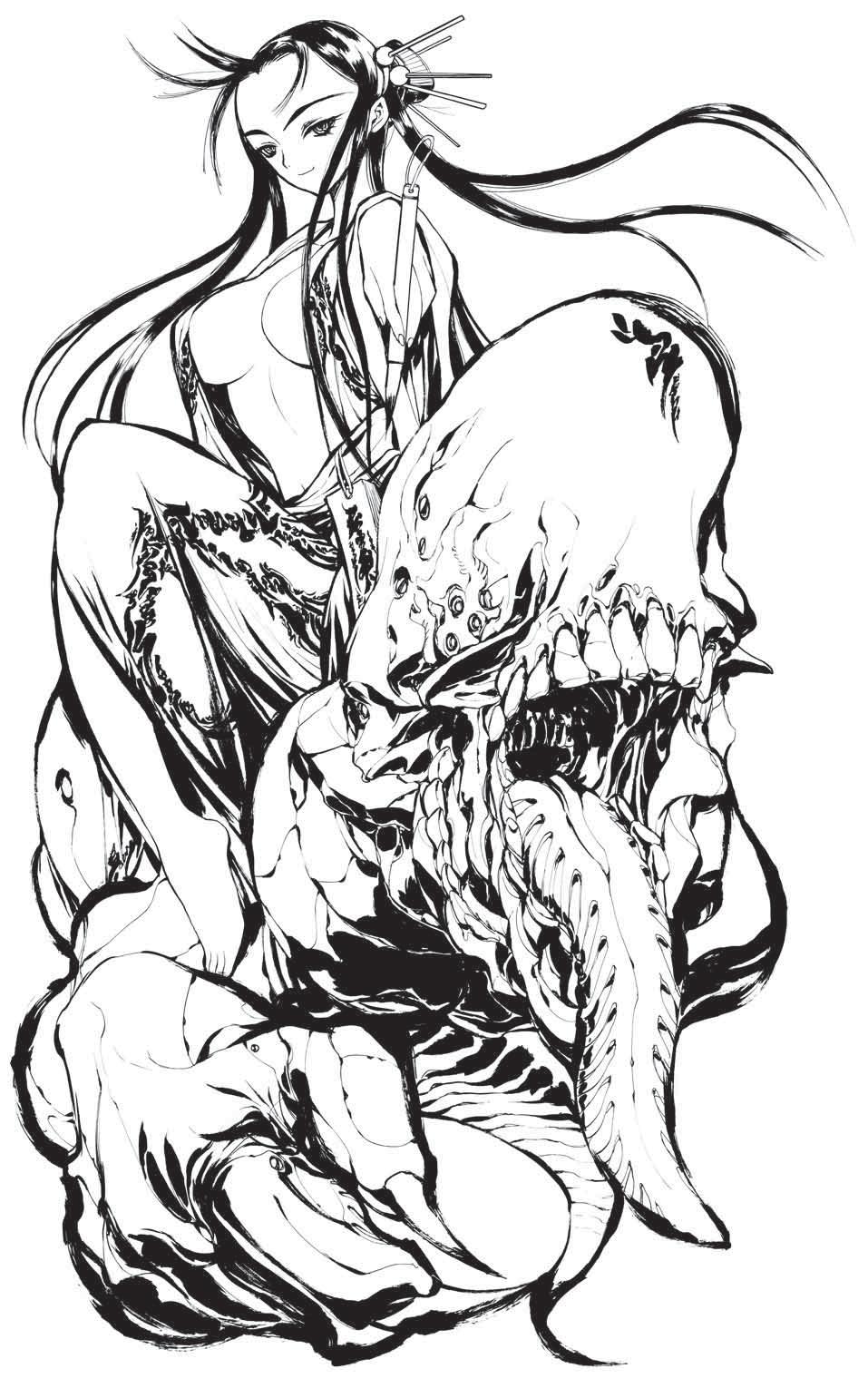
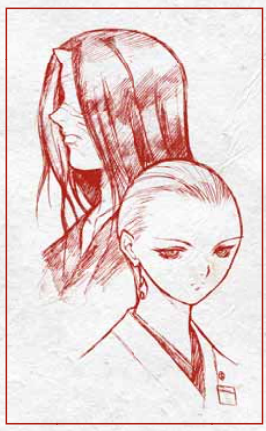
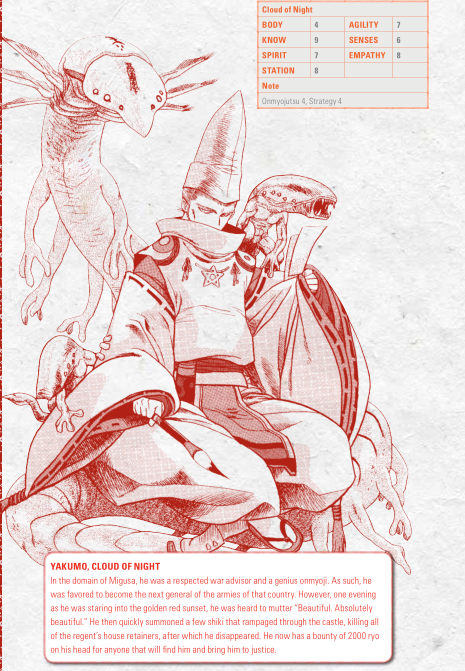
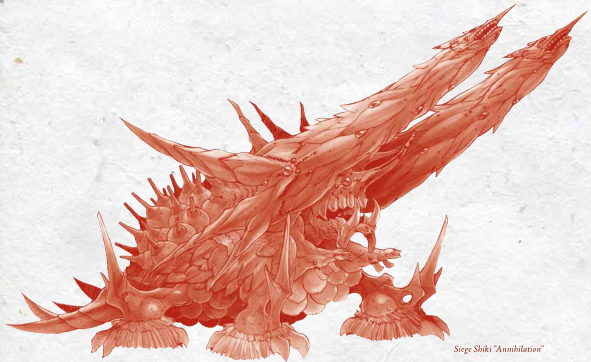
-
Additional Damage
: Self-explanatory. Useful when turning a weapon into a talisman.
-
Combat Ability
: Increases all of the Shikigami's abilities and its Vitality.
-
Explode
: To make a Final Fantasy Bomb.
-
Flight
: For air superiority.
-
Gaseous Form
: Very handy for spy duties.
-
Phantasm
: Allows the sorcerer to target someone with an illusion through the Shikigami. The illusion can cover all sense, which is quite nice.
-
Poison
: For a bit of DOT.
-
Possession
: Vital for talisman creation and of course also able to take control of someone.
-
Prolong Summoning
: Multiplies the amount of time the Shikigami can exist.
-
Ranged Attacks
: Lightning bolts and other fun stuff. Requires Additional Damage to actually do anything.
-
Regeneration
: Makes the Shikigami tankier.
-
Sense Link
: As described above. Has no cost, and the sorcerer can always decide whether the Shikigami has this or not.
-
Shapechange:
It's polymorph.
-
Shiki Destroyer
: This handy ability gives each succesful hit against a fellow Shikigami a chance to destroy it instantly, though the attacker itself gets destroyed as well.
-
Soulfind
: Like the Lifepulse of an Armour, this is used to sense living beings.
-
Transmutation
: The sorcerer picks a substance, and the Shikigami can sacrifice itself to turn itself and any nearby nonliving matter into the substance. Not very useful for a talisman Shikigami as it will not return.
Samurai
Original SA post Tenra Bansho Zero
Let's take a look at feudal Dante.
Samurai
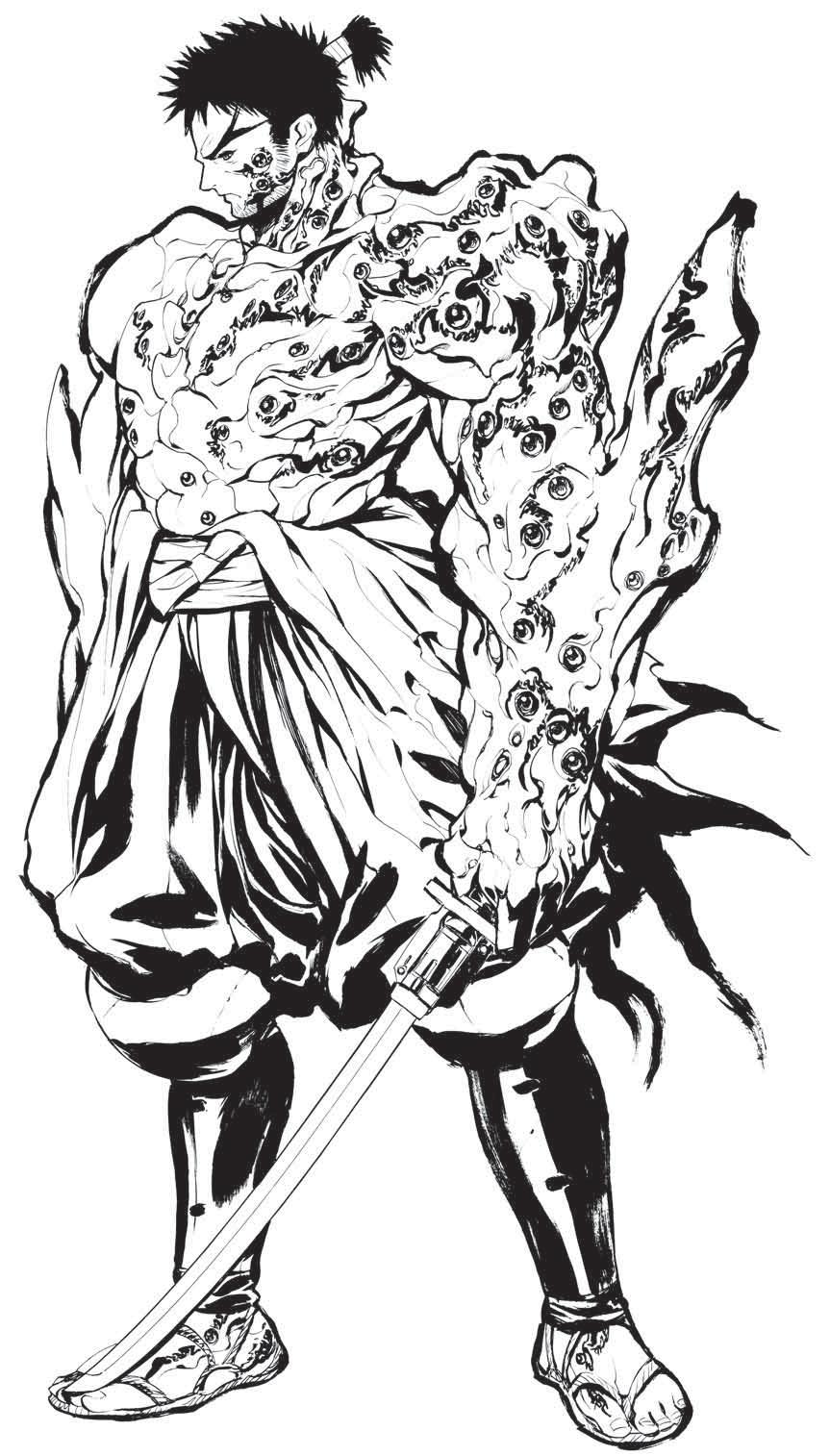
I think you should see a doctor about that. EDIT: Whoops, wrong picture.
Unlike feudal Japan, Tenra doesn't use the term "samurai" to refer to a "proud noble/warrior class guy". That's just a proud noble/warrior class guy. Tenran samurai are rather swordsmen whose path to become the best there is led them down a road that had them exchange their humanity for raw power.
Remember all the talk about talisman? How they usually are inanimate objects with a Shikigami bound to them? Well, a samurai is what you get if you bind a Shikigami to a human body. The are a fusion between man and spirit and can "activate" themselves to add the Shikigami's powers to their own.
Some powers can't be used by a samurai, and others don't make a lot of sense. Samurai typically settle for Additional Damage, Combat Ability, Regeneration and the occasional Flight. You could make a more sneaky samurai who's into poison or illusions, but most samurai aren't that subtle. Ranged Attacks are also an option, but it is gerneral more cost-effective to just pick a soulgem gun.
As a talisman, any Shikigami with Shiki Destroyer seriously ruins their day, though at least this power won't actually destroy their Shikigami and merely force them out of their not-Devil-Trigger.
When transforming, samurai experience more or less severe physical changes, including anything from skin color changes, inflated muscles, chitinous protrusions, wings or a downright demonic appearance. Samurai Gem Sparda would be a totally fine option.
Becoming a samurai involves having a bunch of soulgems implanted into your skin. They house the Shikigami, and the more you use, the less Soul you have to pay to activate the transformation (just like with any summoning). This process can take months, is extremely painful and can easily result in your death. And you have to make sure that the sorcerer performing the binding is trustworthy, as it is all too easy for him to "install" an Explode-based kill switch into the Shikigami, or a mind control trigger. Even a trustworthy sorcerer will most likely insist on a secret code word that can instantly activate or deactivate the transformation, with the added bonus of the caller sharing senses with the samurai.
If the swordsman survives the samuraification process, he is now a sterile demi-human with funky body tattoos and lots of soulgems sticking out of his skin. They're certainly not inconspicuous fellows.
After the binding is complete, the samurai can't just implant more soulgems into himself to reduce the activation cost, nor can he alter or improve the Shikigami. All of this would require to get rid of the current Shikigami and repeat the whole process all over again. This is not only just as dangerous as last time, but becoming a samurai (again) after chargen generally makes your Karma shoot through the roof.
As a dangerous killing machine that gave up its humanity, samurai are both feared and hated by normal humans. But since simple villagers aren't stupid enough to enrage the swordsman that could demolish their entire town, they will usually be very generous and nice to any wandering samurai.
Their immense power makes them popular retainers or mercenaries, though lords and other rich people tend to care more about a samurai's power than the samurai itself. The battlefield is usually the only place they can truly call home.
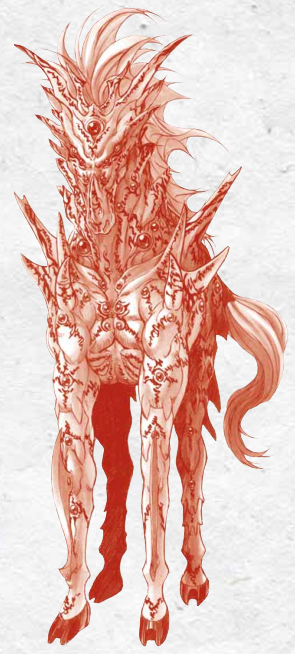
Introducing the PredaHorse.
Aside from samurai, one can turn ordinary animals into talismans. The most popular example is the tenba (aka "heavenly horse"), the only kind of horse that stands a chance in the crazily grimdark battlefields of Tenra.
Next Time : Buddhist monks - You Wa Shock!
Buddhism
Original SA postCrasical posted:
I like the idea of a non-sorcerer who's gotten their hands on a talisman for a Flight/Additional Damage/Explode shikigami and has gone all mad-bomber with it.
Yeah. It's a great way for some added utility and options to spend your Soul on if you don't use it already. And talismans are effectively Pokéballs.
Though Explode is one of those one-shot talisman tricks. Talisman Shikigami can't recover from using a power that involves them sacrificing themselves. Still, you can throw a fake bomb that summons a bomb monster.
Tenra Bansho Zero

Here's how to build Kenshiro.
Buddhism
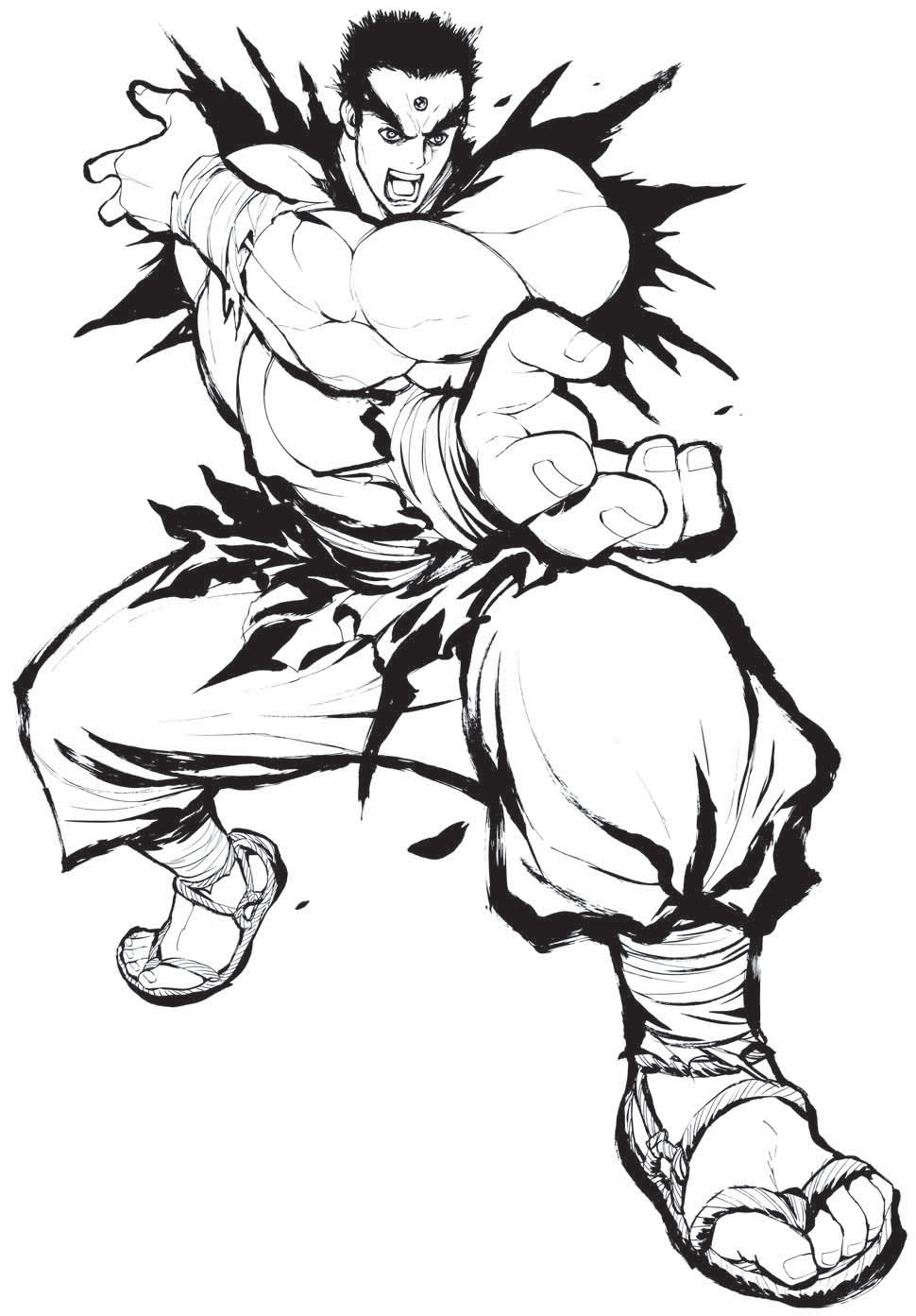
Atatatatatatatatatatat
Buddhism is the only other human religion on Tenra aside from the Shintoism of the Priesthood. Like in Feudal Japan (at least AFAIK), both religions co-exist without much issues, and most people freely integrate both into their daily lifes. As the books tells us, this is because Shintoism focuses on the world at large (as well as the countless spirits and gods living in it), while Buddhism is all about personal enlightenment. As such, they don't really don't get in each other's way.
Wheres the Shinto Priesthood had its schism quite recently, Buddhism has spend centuries split into three major sects:
The Phoenix Sect (Hou-Oh)
The oldest and largest sect, and also the only one that is actually organized and has temples. It's also the only sect sanctioned by the Priesthood.
It was founded when Buddhists formed an alliance with the Shinto Priesthood a long time ago. This was primarily done as to not waste time with a potential conflict the Buddhists would've lost anyways because they don't have spaceships. The Priesthood agreed, and even declared Buddhism the official religion of Tenra.
In order to consolidate power and keep Buddhism from breaking apart under the strain of their new-found influence, the monks all settled on the land of Houga (a nice gift from the Priesthood), forming the nucleus of the Phoenix Sect. As a sign of their alliance with the Priesthood, each monk has a small soulgem (the "Jewel of Buddha") embedded in his forehead.
Readers of ProfessorProf's posts about the Fall of the Phantom Star (aka "What happens if the Shinto Priesthood's orbital elevator decides to pay them a visit") might dimly remember that Houga was one of the countries that got completely annihilated in this disaster.
Fortunately for the sect, the head monk Gamou Douan had a grim vision of the coming catastrophe four months before the fact, giving them ample time to to move to the domain of Togo.
When the Fall of the Phantom Star plunged Togo in chaos, the sect quickly took over the place in order to re-established order. Nowadays, the sect's leadership is deeply troubled and confused over the Priesthood's schism.
As rulers of an entire country, the Phoenix Sect has its own military, using anything from warrior moonks to Buddha-themed Armours and even "onmyo monks" who use both onmyojutsu sorcery and Buddhist magic. They are a highly-motivated force to be reckoned with, but they are a purely defensive army.
With their close ties to the Priesthood, it is only natural that the sect also has a much darker side to it. This side comes in the form of special task forces, from the well-known Kuze Order that closely works with the Priesthood to the mysterious order only known as The Hidden 28th Chamber , whose existance is denied by the head monk himself.
The Ebon Mountain Sect (Bokusen)
This sect splintered off from the Phoenix Sect relatively early. Its founder is Bokusen , a highly-regarded monk who attained enlightenment and found the Phoenix Sect to be too stagnant for his taste.
Bokusen's main philosphy was that personal enlightenment cannot be attained through outside help or a single path, and that it can only be reached by starting from scratch, casting aside all traditional rules and taboos - even those laid out by Buddha himself.
Ebon Mountain monks are therefore a highly individualistic lot that each follow a completely different path, ignoring some or even all of the core Buddhist commandments. Not only can you come across an Ebon Mountain monk who is big into sex, drugs and party, but he will also most likely be a jerk because the typical answer to "How can I reach enlightenment?" is "Find out for yerself, dummy.".
They are however not jerks when it comes to their fellow comrades, as the only real rule for an Ebon Mountain monk is to tolerate other monks and the path they have chosen. This stance makes the sect the only one that actually has female and oni monks.
As most Ebon Mountain monks train their body as well as their spirit, they have also developed a number of martial arts that are considered the deadliest in all of Tenra. The main justification for this (aside from the "train body and spirit" part) is that the Buddhist equivalent of "Thou shalt not kill" is seen as meaningless if one isn't able to kill in the first place. They might have overshot their mark a bit, though.
Luckily for everyone, even the most dickish monk will generally only fight in self-defense.
The Bright Lotus Sect (Myouren)
The youngest sect. It is named after its founder Myouren, a kind and gentle monk who cared more about helping others than about his own enlightenment, gainig him many admirers and followers.
The sect originally started out as a group inside the Phoenix Sect that followed Myouren's Bright Lotus scripture. When the Phoenix Sect feared this scripture was getting a bit too popular, Myouren and his followers found out the hard way that the 28th Chamber does in fact exist.
A few followers survived the bloodbath and helped to spread the scripture over all of Tenra. As wandering monks, they preach to the poor and downtrodden (of which there are a lot on Tenra).
Recently, Phoenix head monk Gamou Douan has officially apologized for the little "mistake" involving the 28th Chamber that totally doesn't exist and declared the movement to be not heretical anymore (which brings to mind the wedding scene from Monty Python and the Holy Grail).
The various regents of Tenra are however less amused about the Bright Lotus Sect, for their simple teachings and focus on attaining a better standing in the next life has led to a huge increase in riots and rebellion.
Buddhist Magic
Buddhist Magic aka Hou-jutsu uses ki to perform more direct magic effects than onmyojutsu. The exact workings of this art isn't clear, and there are surprisingly few monks who can actually use it. Ebon Mountain monks seem to have the highest amount of practicioners (most likely through their training), while Bright Lotus monks see this gift as more of a curse, as they just want to be simple monks that don't steal the Buddha's thunder.
-
Healing Prayer
: The bread-and-butter healing spell.
Spirit Burst : Shoots an energy ball similar to a hadoken. It starts of rather weak and dinky, but improving your Buddhist Magic skill gives you access to stronger versions, until you can spam suped-up hadokens DBZ-style in a single action until your Soul runs out.
Soulgem : So apparently soulgems are not just another red metal like Scarlet Steel, but they are Scarlet Steel that has been turned into spiritual batteries with this hour-long Buddhist ceremony. That's an odd omission of the setting book o_O
Summon Spirit : Your typical "summon the spirit of a dead person to ask him a question or two" spell. The better you roll, the friendlier the spirit.
Subdue Spirit : Monks capable of using spells can see restless ghosts without problem, so they can help them reach the Afterlife. This spell right here is for those ghosts who are still too attached to the world to pass on on without resistance.
Meikyo Seal : This highly blasphemous ceremony seals a summoned spirit into a Meikyo mirror, wiping its memories in the process. I wonder what this could be used for... *foreshadowing*
Meikyo Cleansing : This ceremony reduces a Meikyo mirror's Karma. If there is a soul bound to the mirror (like say of an Armour Rider who went Asura), reducing the mirror's Karma to 0 is the only way for the soul to be released and pass on to the Afterlife. Since Asura's are dicks, their soul will try to resist, possibly slowing down the Karma cleansing process.
Exorcism : Your typical spell to free a possessed person. In TBZ, the culprit is either a Shikigami or an Ayakashi (the supernatural critters of Tenra).
Binding Prayer of Acala : Tries to bind an opponent in place, preventing him from moving or taking any offensive action as long as the monk keeps on chanting.
108 Factions of the Lords of Light
A term used for the various kinds of martial arts practiced by Buddhist monks. They are Arts of War , which are essentially skills you learn and improve to gain special (mostly passive) techniques. The 108 Factions are all Arts of War focusing on making your unarmed attacks the most dangerous there are.
Almost every new technique of any of these styles boosts the Unarmed Attack damage, with a true master able to hit like a cannonball and outdamage any standard melee weapon aside from a soulgem polearm or the Zakt-8R Ultimate Edge (though both of have to use soulgems to compete).
Though these styles are mainly used by Ebon Mountain monks, any monk can learn them.
Fist of Acala the Immovable Lord of Light (Fudoh Myoh-oh Ken)
The first of the martial arts, this style is big on risky counterattacks where the monk can decide to have the winner of the contested attack check deal damage as if the defender had 0 successes (leading to a world of hurt for the loser).
Practicioners of this style can also choose to use their Spirit attribute instead of Body for their Unarmed Combat skill, allowing for the old, frail-looking kung-fu master trope. The capstone technique is called Fist of Acala and lets you spend Soul to add your Spirit attribute to any physical roll for one round, giving you a nice buff.
The Hands of Merciful Kannon the Thousand-Armed (Senju Kannon Ken)
Called that way because the style eschews fists for open, cutting hand strikes that are so fast the user appears to have multiple arms. The "Merciful" part comes from being able to use Empathy instead of Body for Unarmed Combat.
Thanks to the high speed attacks, a practicioner of this style can overwhelm his enemy with feints. This allows him to double the margin of success on his attacks and counterattacks, allowing him to utterly demolish n00bs. The capstone is Thousand Unsettled Hands of War , which is like Fist of Acala except that it uses Empathy.
Celestial Form Kung Fu (Seishaku Kei-i Ken)
A martial art said to have been created by studying the stars in the sky. It's totally not Hokuto Shin Ken. And the first technique is only called The North Star because... because.
The main gimmick of this style is that it needs to be charged, with each technique requiring both an action of preparation and all lower-level techniques to have already been prepared. So to you the style's full potential, one has to either charge up over multiple rounds like a DBZ character or spend a couple Kiai points to buy additional actions.
In exchange for this charging up, you gain the biggest Unarmed Combat boosts there are. The penultimate technique The Heavenly Gate gives you a +15 (only surpassed by a Zakt-8R unloading its entire magazine), and the capstone technique The Broken Army gives you a +40, which allows you to knock out pretty much any Armour with one hit (or two if the Rider decides to check off the Dead Box).
That's right. Stay in the background, charge up for a while, destroy everthing you touch. You are already dead indeed.
Next Time : Kijin - harder, better, faster, stronger.
Kijin
Original SA postLatwPIAT posted:
When I listened to the April Fools' Duckman RPG review, I thought that it was based on an entirely made-up 90's cartoon, mixing all the tropes of low-budget "underground" animation into one parody that then was the basis for an entirely fictional RPG; one of those completely forgotten shows that occasionally gets mentioned by someone who was a fan, but has otherwise been so forgotten that basically only IMDB and a fansite from the 90's remembers it exists. I only learned today that Duckman was an actual cartoon.
I can vaguely remember having watched a few episodes, though I can't tell many details aside from Duckan talking a lot.
theironjef posted:
Sadly it's neither our idea nor something we're actually doing. However I can tell you a similar anecdote about late night weirdness, in that I was hanging around with a friend one night playing SNES Biker Mice from Mars when Adult Swim first launched an unannounced pilot of the first Adult Swim lineup. Sealab 2021, Harvey Birdman, Aqua Teen Hunger Force, The Brak Show. We were 100% gobsmacked and spent a week trying to figure out what the hell we had just encountered.
This reminds me of my first episode of Ren & Stimpy.
Tenra Bansho Zero

Now lets look at some cybernetics.
Kijin
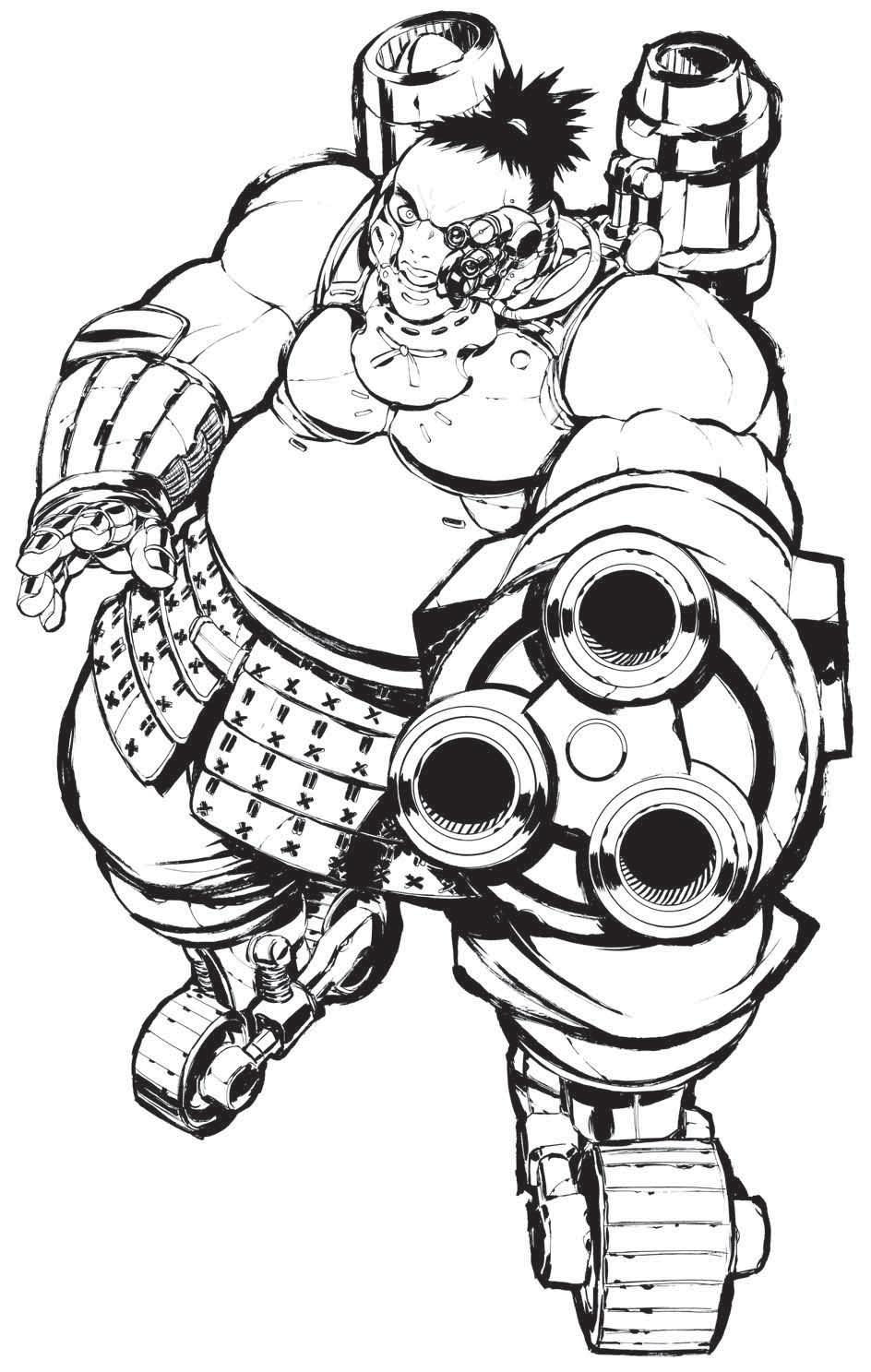
Talk to the gatling
Kijin (aka "machine men") are a fairly old technology used by the Priesthood for some time. But it was only after the schism and the Northern Court's more open policy regarding that the rest of Tenra gained the necessary surgical knowledge and tools to create Kijin with a worthwhile success rate.
Kijin are the magitek cyborgs of Tenra, with the magic part mostly limited to allowing the Mechanica aka cybernetics to use ki in order to integrate themselves into the Kijin's nervous system. Mechanica can replace entire limbs, eyes and in extreme cases even the entire head and torso. Internal organs can't be replaced though, making the last two modifications tricky.
As creating a Kijin is relatively easy and results in a [markable] boost in speed and combat prowess, the lords of Tenra are more than willing to not only give their crippled soldiers free medical treatment, but also make them better in the process - whether they want to or not.
As any single battle on Tenra creates a lot more Kijin candidates than it kills off existing ones - not to mention the amount of soldiers who replace their normal limbs willingly in order to gain power - , the Northern Court has started a rather disturbing trend of armies having an ever-increasing contingent of cybernetic freaks.
The big problem with this development (which again is purely for roleplaying purposes and has no actual rules attached to it) is that the more you become a machine, the less you are a human in both body and spirit. It is only a matter of time till one turns into an inhuman monster.
Even before this could happen, many Kijin refuse to go back to their families. It's probably pretty hard to fit back in society if your head looks like this:
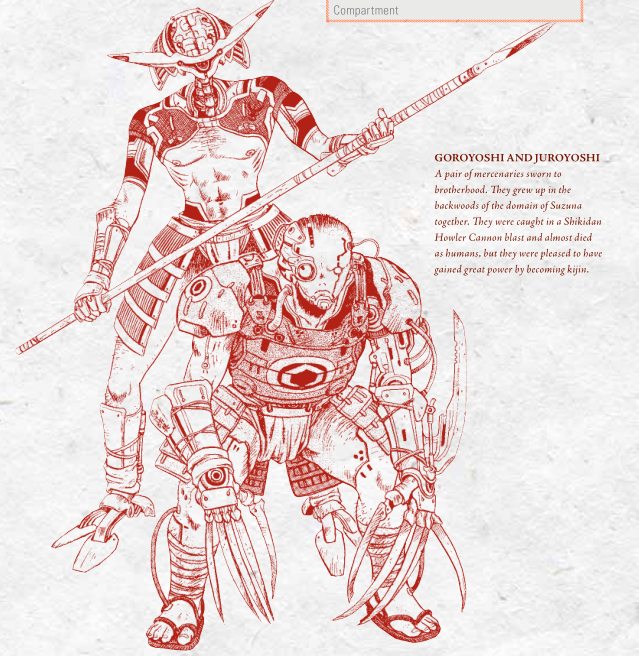
Now this is a lot more like a diaper. Also, Vajra Claws are awesome.
Mechanica Rules
Mechanica replacements for the various body parts come in three classes of quality (Hei, Otsu and Kou), each granting a better passive bonus and offering more slots to put neat stuff into. If the Mechanica of your chosen class doesn't have enough slots, you can generally cram more stuff into it by reducing the passive bonus. All but the head-based Mechanica also let you turn slots into storage compartments.
The downside to all of this is that each Mechanica gives you a penalty to your starting Attribute pool (most likely put into the mental Attributes to represent the cybernetics eating at your soul). The higher the class, the more severe the penalty. If you want to become a Kijin after chargen, this penalty translates into a heft cost in Kiai points, which ultimately boosts your Karma.
Aside from these slot-based mechanica, there are also smaller additional mechanica or big ones that replace the entire limb without room for slots. They also have Attribute penalties.
It should be noted that all of these mechanica can also be used by Armours. Their Attribute penalty always applies to the Rider, and it can be reduced by increasing the Armour's Karma cost.
Some of the most powerful Mechanica require a Heart Engine to operate, which in turn requires a Mechanica torso. This can only be done at character creation.
Eyes and Heads
The standard Mechanica Sensor replaces one of the Kijin's eyes and the surrounding area (usually the right one). They provide a nice HUD for a bonus to Notice checks. Aside from the three standard mechanica classes, you can give yourself a Rotating Visor that is a swiss army knife of various different eyes. This only offers a moderate Notice bonus, but boasts the greatest amount of slots.
The slots can naturally be filled with all sorts of stuff to improve your senses and also includes the Eyes of Distant Death which like the Armour-version are great for ranged attacks. Offensive options come in the form of the Flash Burs which blinds people and Eye-needles that hits people with most likely poisonous needles. For a somewhat 40k-ish flair, you can get yoursel a Floating Eye that can detach from you (though it has to stay connected to you via wire).
Aside from those slots, there are Lightning Bolt Eyes that require a Heart Engine and do exactly what they sound like. A Heart Engine also lets you have a Mechanica Kabuto that replaces your entire head and offers magical ECM capabilities. Armour Riders can benefit from an Interface Helm Implant , and any fighter would likely want a Supreme Nervous System for a nice initiative bonus.
Unlike a lot of other RPGs that include magic and cybernetics, Kijin aren gimped when it comes to using magic in any ways. As long as they can still draw / make gestures and chant incantations, they are totally fine.
If anything, they can be made better at this stuff. A Brain Enhancement boosts their Soul pool, and the Renju Voice is a pair of magical spinning disks in your lower jaw that help you with gathering Sha energy, adding a dice bonus to magic skills.
Arms
The standard Mechanica arms naturally boost the damage you deal with melee and thrown weapons. Unsurprisingly, most slots are dedicated to built-in weapons. Hightlights aside from the always rad Vajra Claws include the White Heat Palm that allows you to turn your Soul points into damage, the Five-barrel Gatling that make you like Aigis from Persona 3 in that your fingertips double as a galting, the retractable Grudgle Blade for your simple arm blade needs, and the pretty cool Omega Snake Blades that are wrist-mounted spikes that spin around at high speeds. Oh, and there are also Projectile Fists if you want to be Mazinger.
For a defensive option, you can get yourself a Steel War Fan which is basically a shield. And to further improve your Kijin sorcery, you can install multi-jointed Kairen Fingers like some guy from Ghost in the Shell.
For fun, you can have a Lizard Bomb Arm to not only detach the arm, but let it explode as well.
Full arm replacements without slots include the Demonic Lightning Cannon which shoots lightning bolts, the Cyclone Gatling Repeater that replaces an entire arm for a gatling with a ridiculous ROF, the Kaminari Fist Thunderburst that is essentially a Power Fist with huge spike damage potential (that unfortunately destroys the hand in the process). With a Heart Engine installed, you can also have Crab Claws , which are not only nifty melee weapons but can also double as a friggin' Wave Motion Gun.
Torso
A Mechanica torso increases your Vitality and allows you to put a bunch of armour-style cannons and mortars into its slots. A Heart Engine also goes here, as does a Kimenkyo (which allows you use your Interface skill in place of a general skill, kind of like how a Armour Rider does it). If you want more arm weapons, you can get yourself an Extra Arm Attachment .
Other weapon systems include the nasty Rib Cage Spider which lets you impale people after grappling them, the Glorious Death Bomb for a self-destruct device, and the always popular Flame Caster to burn people.
For support needs, you can get yourself improved lungs for underwater acction, flight and a smoke screen.
Other Mechanica for this torso mainly deal with skin replacement, like the Zero-type Reflective Armor for resitance against energy and magic attacks, or the Type 3 Chameleon Flesh Dragon Scale which uses the power of a Heart Engine to turn you into the Predator.
Legs
Mechanica legs boost movement speed, and you can fill the slots to give yourself rollerblades, fins or jump jets. Shock Absorbers let you half falling damage, and you can also have Lizard Bomb Legs for the same trick as the arm version.
For weapons, you have the Leg Incinerator (which is just a White Heat Palm for your foot), Dragon Claws (which also double as climbing aids) and the Supreme Howler Mortar Cannon which is a Heart-Engine-fueled mortar.
Other Mechanica
The "Explosive Corpse" Skull Bomb is a bomb implanted into your skull that acts like a kill switch (though you can actually surive this thing going off, even if it forces you to check your Dead Box). A Weapon Interface links a built-in weapon directly into your nervous system for a damage bonus, and Weapon Attachment lets you attach any normal weapon to your mechanica.
Twin Dragon Arms are actually arm Mechanica, but they are installed in such a way that they don't get in the way of any other arm Mechanica, though it requires a Mechanica torso slot for ammo. It's a gunpowder-based machine gun with a blade.
Homeopathic Bullet Skin is an odd little Mechancia that uses skin replacement and gunpowder charges to create a kind of reactive armor. It lets you negatve incoming damage once at the costs of having to fill one of your wound tracks.
Next Time : Kongohki - Ghost in the Mirror.
Kongohki
Original SA postI'm on a roll right now. Let's tackle the most metal player option:
Tenra Bansho Zero

Kongohki
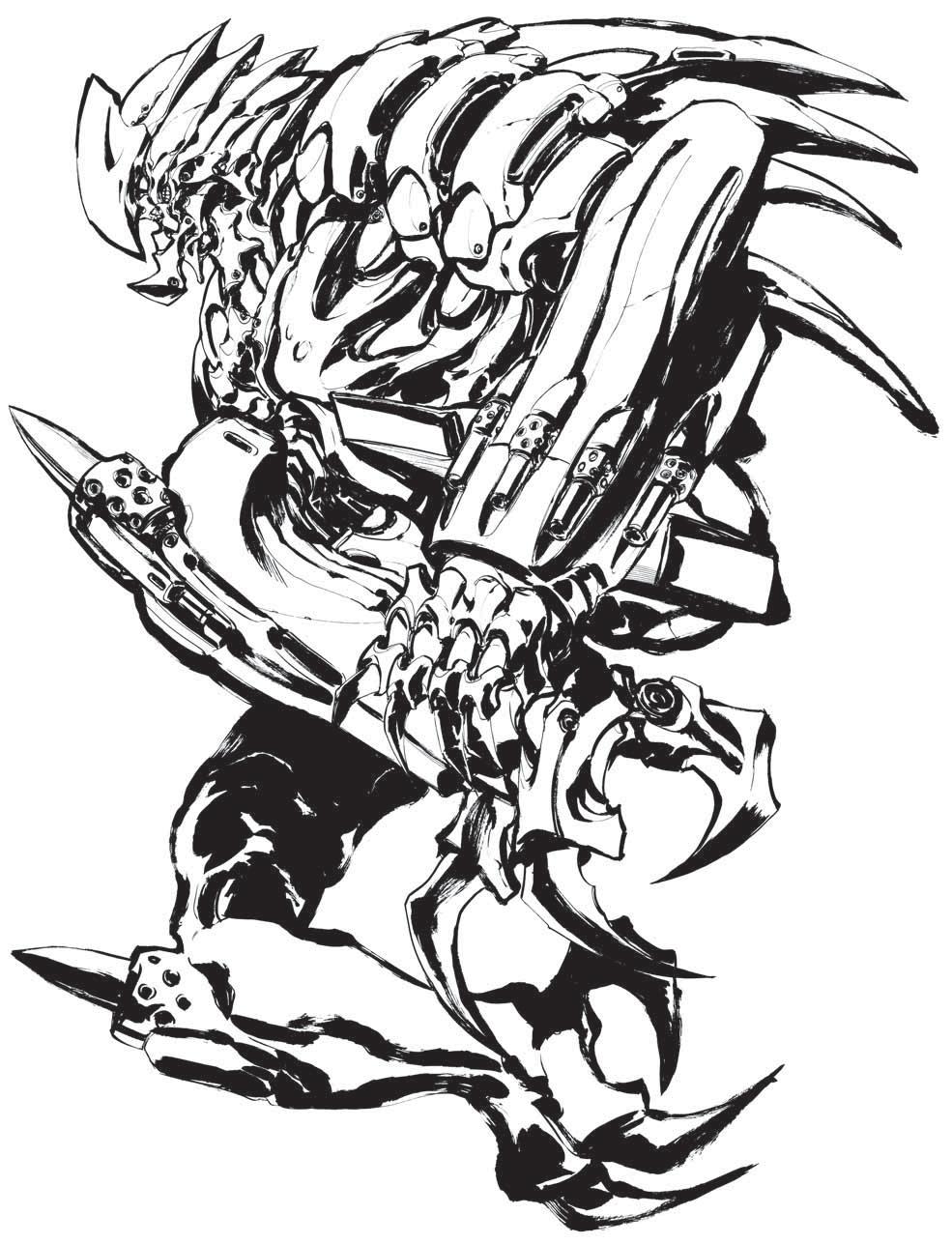
Part blades, part guns, all metal.
The battlefields of Tenra are filled with lots of scary opponents to face, be it giant robots, samurais hulking out, or freaky cyborgs. But nothing is quite as pantsshittingly scary as the
Kongohki
- aka "The Unbreakable Ones", aka "The Machines of Vajra", aka "surprise magitek killdroid that move faster than your eyes can follow".
Kongohki are the result of trying to figure out a way to miniaturize Armours. Power-armor-sized Suit Armours took a while to take off is because the more you miniaturize, the more the Rider's body gets in the way.
Sometime in the past, someone apparently went "If Riders transfer their soul into the meikyo mirror when piloting their Armour, can't we just get rid off their bodies somehow?". And that's the whole trick: Summon the spirit of a dead Asura, put him into a meikyo mirror (out of which he can't escape thanks to his Karma), mindwipe him and violà. You've got yourself an obedient magitek robot.
Alternatively, you can just yank out the meikyo mirror out of an Armour whose Rider went Asura. Then you just have to mindwipe it.
Thanks to them not having to store the useless fleshy body of a pilot, they are comparatively lightweight and effectively designed (to the point some of them look like skeletons). This helps them with their
Overdrive
ability that lets them move at blinding speeds, allowing them to add an exploding die mechanic to their physical checks. A Kongohki with high skill ratings is pretty darn scary.
Like Armours, they gain bonus die based on how much Karma they have. Unlike meikyo Armours, they don't have to keep track of two Karma scores or have to worry about instantly turning Asura when they reach 108 Karma. This gives the mass-produced Kimen Kongohki less advantages compared to a Kimen Armour, but having easier access to replacement and alternative parts is still nifty.
The big roleplaying gimmick of the Kongohki (which actually has rules and is tied to a mandatory Fate) is that their mindwipe seal
will
start to weaken, resulting in confusing flashbacks of their former life (which you can just come up with on the fly unless you / the GM actually want to plan this out from the beginning) until they finally remember everything.
When a Kongohki uncovers his former self, one of three things happens: Either they go "Screw old me!" and move on, they start liking their past and essentially continue were they left off, or they just go insane and go on a rampage. The latter is the most common outcome. It can also happen that the new personality is so strong that it erases the old memories before they can completely surface.
Alternative Kongohki types
Aside from the the meikyo/kimenkyo mirror divide like with Armour, there exist a few special types of Kongohki:
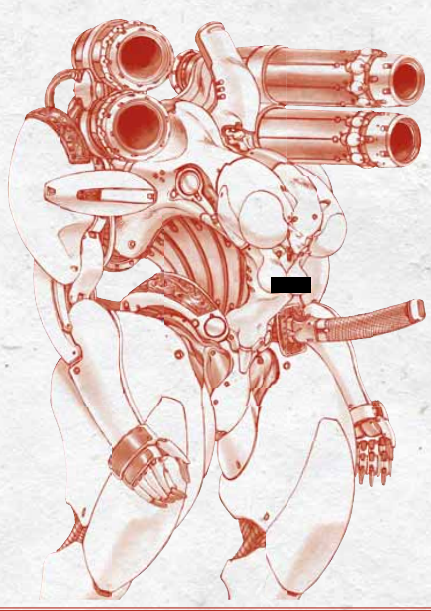
Classy.
Heavy Assault Units
are the result of reversing the miniaturization process, creating Kongohki that can reach the height of a medium Armour while still retaining their Overdrive ability. Similar to Great Armours, they have several "pilots" in the form of additional mirrors with Asuras bound into them. Heavy Assault Units tend to have one or two primary mirrors, with any additional mirrors being mindwiped so hard they barely have any sentience left and just act as gunners.
The big problem that makes these units so rare is that the high amount of bound souls in close proximity makes it very easy for one of them to go crazy.
Kongohki Servants
are soulless Kimeno Kongohki that are controlled by a Shinto agent - the Puppeteer - interfacing with them and taking over the body. This removes the whole "bound Asura remembering his past" business, but it comes with the drawback that the Shinto agent's own body will fall into a trance and be an easy target.
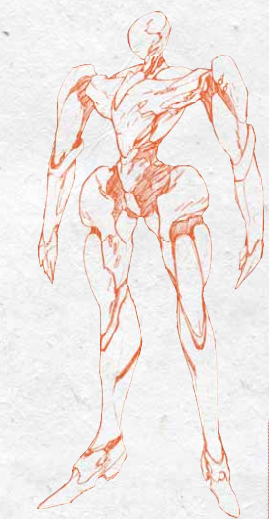
Slendergohki?
Aside from these Servants, there are the Priesthood- and NPC-exclusive
Priesthooh Kongohki
who are only used as guards for the two Court's HQs and the occasional assassination mission. They are extremely powerful (with physical attributes in the 20s), not powered by Heart Engines and apparently not made or run with any kind of magic. They're totally actual robots, or drones depending on whether or not they are remotely controlled.
They have no visible weaponry, and their statblock just calls their weapons "Left Arm" and "Right Arm". One of these is a ranged weapon, and I like to imagine that they shoot laser beams.
Kongohki Construction
This is a quick one: Kongohki are created just like Armour with the addition of mental attributes and can also take advantage of all the nifty Kijin armour. This lets you get pretty crazy with the design, be it a spider Kongohki or a multi-armed wizardbot.
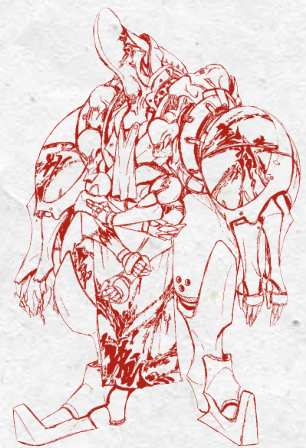
This is what happens if a crazy onmyojutsu sorcerer turns Asura for the sole purpose of getting a rad Kongohki body optimized for spellcasting. Can't blame him.
Though Kongohki do have somewhat different options: They can have a beast-like head and don't have miniature versions of some of the really big Armour cannons.
Bottom Line
Kongohki are probably the most badass alternative to a resurrection spell. Who wants to go back in his old body that failed you before if you can start a new life as a speedster death robot? Sure, you won't remember anything from your previous life, but that will just make it easier to come up with flashbacks.
Next Time
: Ninja - can TBZ grimdark them up?
Ninja
Original SA post Tenra Bansho Zero
Teenage soulgem ninja humans.
Ninja
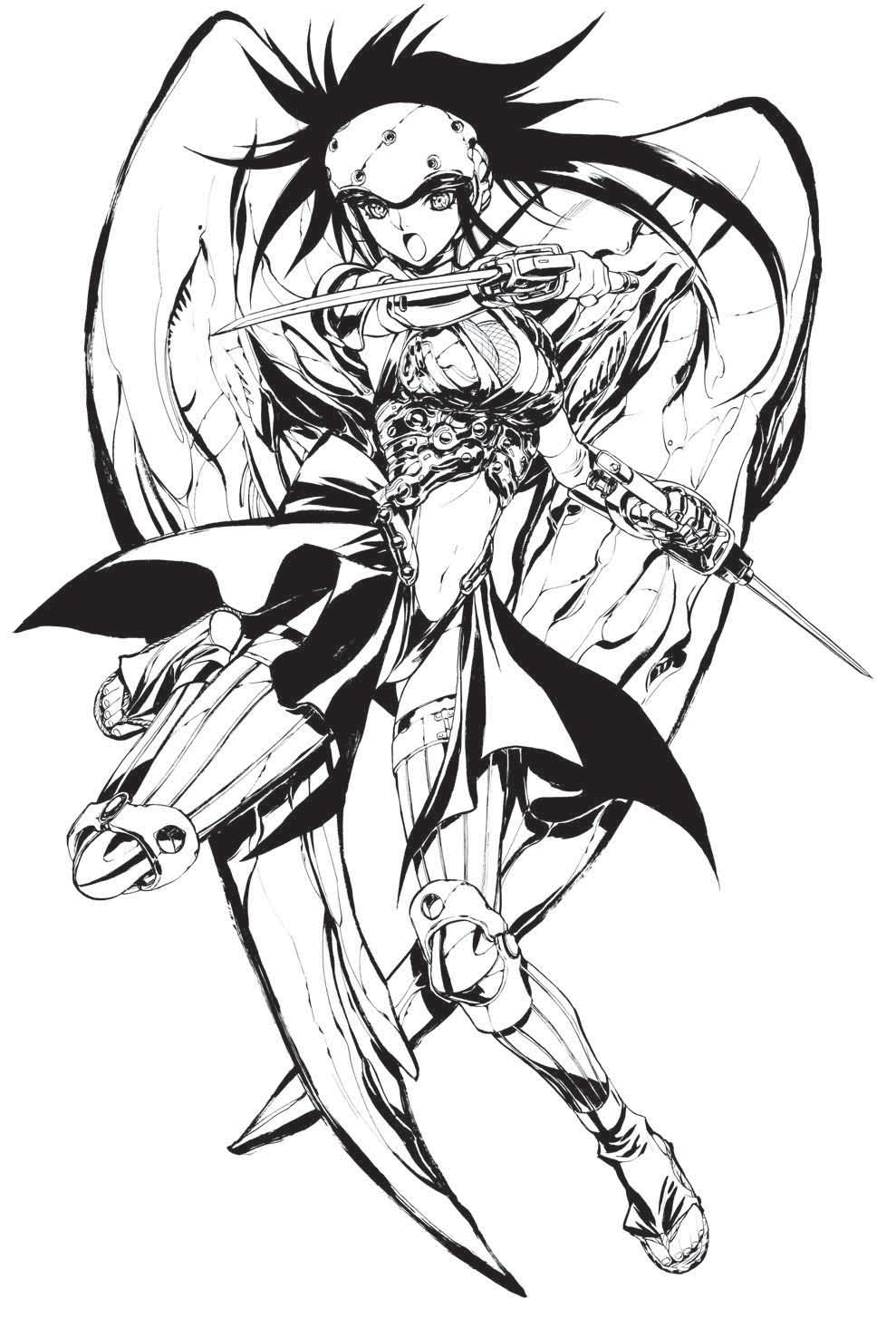
Why do ninja always wear silly headgear? Well, at least this one looks like it is bulletproof.
Unlike Samurai, the TBZ Ninjas are pretty close to the source material: sneaky guys organized in clans hired to perform various kinds of shady and dishonorable missions.
Because of their sneaky nature, nobody really knows when or how this whole ninja deal started. All that anyone knows is a name: Makabe Genyuusai . No real facts are know about him, but it seems he was a rogue onmyojutsu sorcerer who discovered and formalized unorthodox, stealthy and Shikigami-less applications of omnyojutsu that could be learned and used without really understanding them: Ninjutsu .
Living as a Ninja is certainly no easy life: Your employer - heck, your entire clan - sees you as a mere tool that better not ask any questions or develop something like morals. You can also forget any sort of recognition because success was expected. You do what you're told to, and nobody will ever find out what you did or if you ever existed. And of course, failure equals death. Don't even get me started on treason.
In other words: Play a Ninja if you want a more serious version of Paranoia.
Having doubts over once life as a ninja and trying to flee is a good way of getting killed by your former comrades. This also means that rogue Ninja are also the most dangerous, as only they were bad enough dudes to survive the hunt.
The Dark Arts
The only real kind of promotion in the world of the Ninja invovles becoming a Shinobi . This word has no special meaning outside of the clans and is used interchangeably with "ninja", but the clans use it to describe a Ninja that makes use of the Dark Arts : By having soulgem fibers implanted into their bodies, they can channel Sha energy much more efficiently, allowing them to spam NInjutsu techniques much faster than ordinary Ninja.
This whole operation is a bit like the samuraiification process (both of which are incompatible with each other) , except without the Shikigami part. Unfortunately for the Ninja, their operation goes a lot deeper and requires their entire body to be cut open. Think Wolverine's adamantium treatment without the healing factor. Yikes.
If the new Shinobi survives the procedure (which the Northern Court's newly-published medical know-how only managed to marginally improve), there is a very good change he'll suffer from necrosis as is body tries to reject the soulgems.
Like a Samurai, the Shinobi are sterile, and their clan will insist on them producing an offspring before the operation to pass on his genes to a new generation, which is at least something.
A special sub-category of the female Shinobi are the Kunoichi , who specialize in disguising themselves as concubines, or other professions where being steriles comes in handy. Thankfully TBZ doesn't get into too much detail here.
Ninjutsu schools
Each clan teaches one or more schools of Ninjutsu, which decide what kind of techniques a NInja can use. The book presents seven schools, but more can be created rather easily.
-
The School of Dream (Oboro-Ryu)
: A very orthodox school that was also the first to come up with Kunoichi.
-
The School of Shadow (Kage-Ryu)
: The extra sneaky school that also makes use of dogs and other animals. It's basically Galford's school.
-
The School of stone (Gan-Ryu)
: A school that sees itself as the true successor of the original Ninjutsu and has a bit of everything.
-
The Ghost Clan (Rei-Ryu)
: Both a school and a clan to go alongside with it. An offshoot of the School of Dream with an heavier focus on combat training.
-
The True School of Shadow (Shin Kage-Ryu)
: An offshoot of the School of Shadow which is double plus sneaky and fond of smoke bombs.
-
The School of the Shore (Migawari-Ryu)
: An unorthodox school focusing on combat, especially thrown and ranged weapons.
- The School of Dust (Jin-Ryu) : The school for those Ninja who just like to blow stuff up.
Ninjutsu
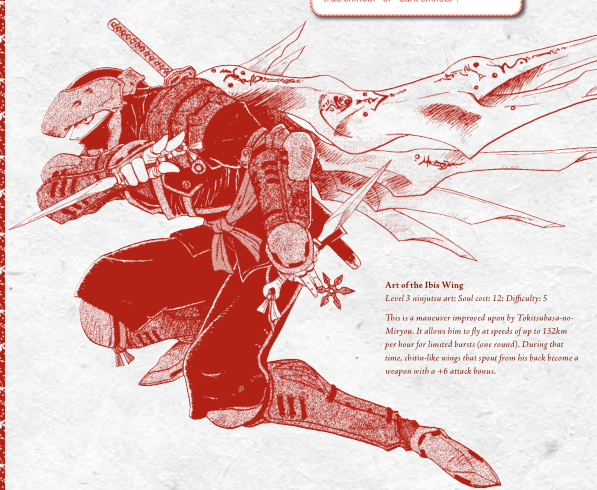
They really get their mileage out of their fancy wings
Ninjutsu is bought as a skill (with each school being treated as a separate skill) that grants the character Ninjutsu techniques as he goes up in rank. The first rank of every school also comes with two Ninja Paths that allow you to use the Ninjutsu skill rank in place of another skill. The "Path of the Cunning Sparrow" for example lets you roll Ninjutsu instead of Stealth, while the "Path of Denial" does the same for Evasion.
Two Paths are the odd man out in that they instead grant a special ability: The "Path of Broken Earth" boosts your movement speed and gives you bonus dice for every first attack in a combat against any enemy (because your speed catches them off guard I assume), while the "Path of the Smoke Bomb" lets you escape from a scene by using a smoke bomb.
Each technique requires what are essentially material components (like medicine, or a cloak; some techniques just require gestures) that you generally don't have to worry about unless you are captured or toss it away purposefully, a Soul Cost (which Shinobi get to reduce) and the Difficulty you have to beat with your Ninjutsu check.
A neat mechanic I like is that your margin of success for the check is turned into a pool of bonus dice you can apply to checks related to the technique, as long as it makes sense. You can even give these bonus dice to other PCs (if say your technique causes a distraction your fellow comrades could exploit). Some techniques also allow you to spend those dice to make whatever effect you've caused harder to resist or get rid off.
In an odd similarity to D&D, there are a quite a few techniques that come in pairs, with one being the "lesser" and the other being the "greater" version, with the greater version naturally being more expensive and (usually) harder to perform, but offering greater and/or longer effects. I'll list them as one entry to safe space.
This system also helps showing off how the various schools specialize in different techniques, as some only gain the lesser version of a technique pair.
-
Possessed by the Inner Wolf/Demon
: A buff to your physical checks, kind of like a typical Samurai.
-
Iron Fist / Wind of Menace
: A damage bonus to melee and thrown attacks.
-
Ball of Thunder / Exploding Thunder Ball
: Let's you quickly mix a small explosive; it's essentially a fireball spell.
-
Shadowflight / Blackhawk's Shadow
: Transform your cloak into a pair of wings to fly, glide or jump at great speeds.
-
Shadow Form / Four-fold Shadow Form
: Play doppelganger and take on the appearance on someone you have concentrated on.
-
Ninja Duplication Technique / Shadowless Replication Technique
: Create one or more clones of yourself at various levels of competence. A helpful sidebar tells us that the classic "fool enemy by having him hit a dummy of you" trick can be pulled off either by having a Duplicate enter the scene for you, or by just fluffing out the description of your evasions or counterattacks.
-
Smoke and Mist / Phantom Mist Delusion
: Confuse your opponents with illusions.
-
Shadow Stitch Technique
: A pretty fun technique that allows you to bind an opponent in place by hitting his shadow with a kunai or shuriken.
-
Mind's Eye / The Thousand Eyes
: Allows you to sense life forms around you. Pretty nifty for sneaking into a lord's castle. You do have to eat an animal eyeball, though.
-
Venom Eater / Annelid Body
: Apparently licking a poisonous frog allows you to store its poison in your body. You can apply it to a weapon by cutting yourself, give people a poisonous kiss, and it reduces the strength of any other poison you get affected with.
- Steel-Cutting Hair : Slice people by whipping your hair. Is anyone here familiar with Shantae?
Ninpou Techniques
The ultimate ninja arts you learn from mastering a school of Ninjutsu. Each school only has one of these, and there are more Ninpou Techniques than there are schools, encouraging the GM (or the players) to come up with new schools. A lot of these can only be used once per session due to the amount of materials and preparation required.
-
Explosion-in-Hiding
: Not only do you pull off the ninja dummy replacement trick, but the dummy in question is also filled with explosives.
-
Insect in the Grass
: It's like Exalted's Perfect Dodge, except very expensive and hard to pull off.
-
Flying Squirrel of Destruction
: Body-slam your opponent and then explode a gunpowder charge which hits everyone in the area except for you. You can probably reflavor it in hitting your enemy so hard they explode directly.
-
Rod of Lightning
: Act as a lightning rod for AoE damage, which also doesn't damage you. This does work indoors and underground; the lightning just wrecks everything that gets in its way.
-
Heaven's Dark Death
: Rob the target(s) of all of their senses for free sneak attacks.
-
Crimson Spiders
: Cover the target in a web that just so happens to include a swarm of spiders that suck blood. Lovely.
-
Toad of Jiraiya
: Summon a giant frog with excellent physical attributes and skill ranks.
-
Vinefall
: Grab the target, jump ridiculously high in the air, and hurl him back down for some nice damage bonus. Can probably also be reflavored into a Spinning Piledriver.
-
Rain of Blood
: Cut yourself to turn your own blood into auto-hitting poison.
-
Spider of Darkness
: Create a shadowy tentacle to impale people.
- Shattered Illusion : This one permanently turns you into an anti-ninja: ninjutsu techniques will no longer work on you, but you will also no longer be able to use them yourself.
Next Time : Kugutsu - I wanna be a real girl.
Kugutsu
Original SA post Tenra Bansho Zero
What happens if you combine Pinnochio with Metropolis? Maybe something like this:
Kugutsu
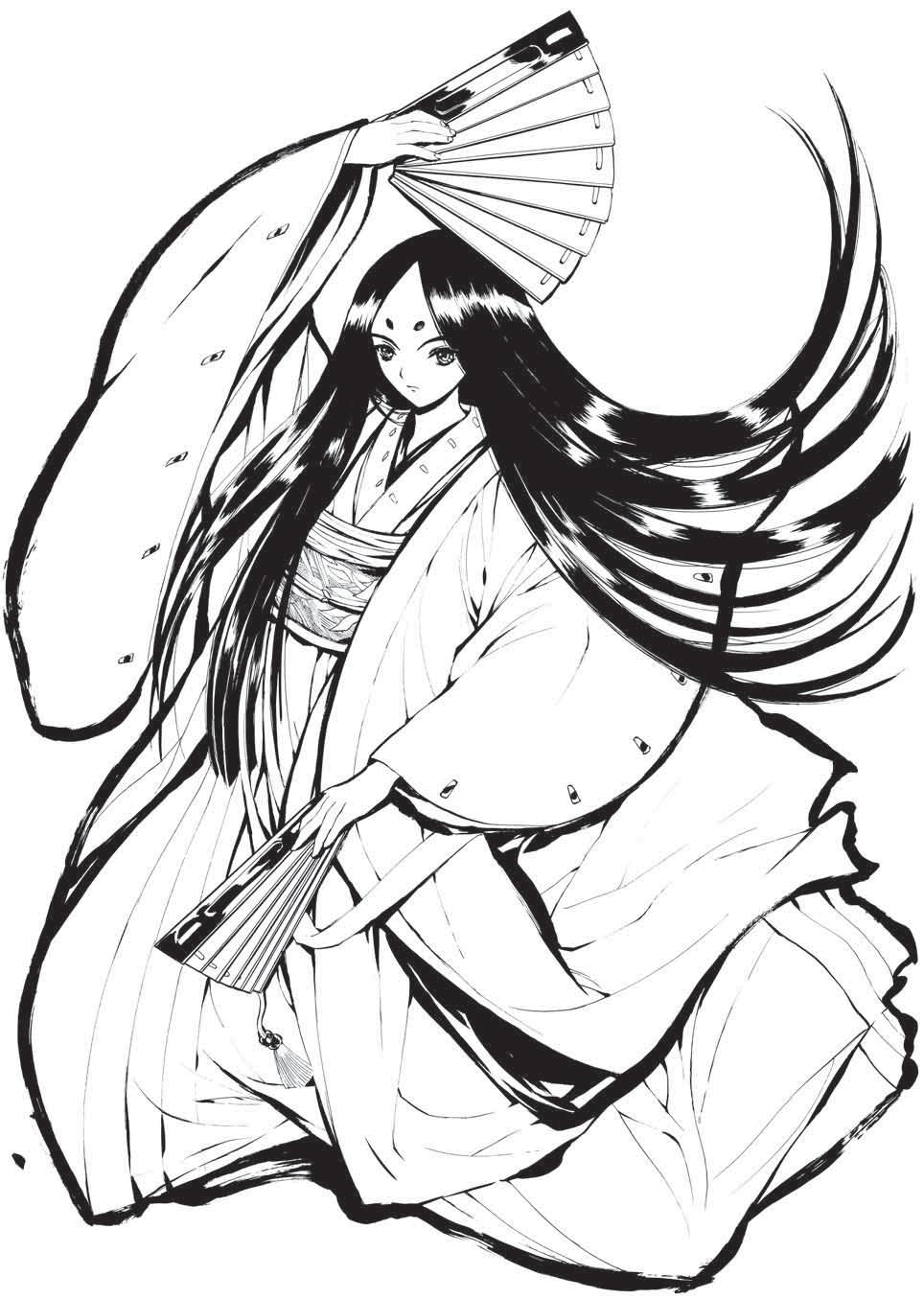
I think you can make a pretty big tent out of that fabric.
Kugutsu (aka "puppets" or "marionettes") are artifical women. Mannequins carved from sacred trees and given life by onmyojutsu and tree spirits, they are perfection in body, mind and soul. They are both art and human, and the ultimate status symbol for lords and regents. Owning a Kugutsu is like owning the Mona Lisa - if the Mona Lisa could also dance, recite poetry and make some damn fine tea.

Before...
While initially only wooden dolls, a magic spell known as the Illusion gives them a soul and an appearance that is indistinguishable from humans. They can even bleed, and the only think that can tip people off is that they turn back into dolls upon death and don't age, as to not tarnish their beauty.
As they can think and feel just like a human, quite a few Kugutsu can't stand living in a golden cage and flee from their owner, forcing them to hide their true identity. Some Kugutsu may not even be aware that they aren't human. Either of these two is the typical background for a player Kugutsu.
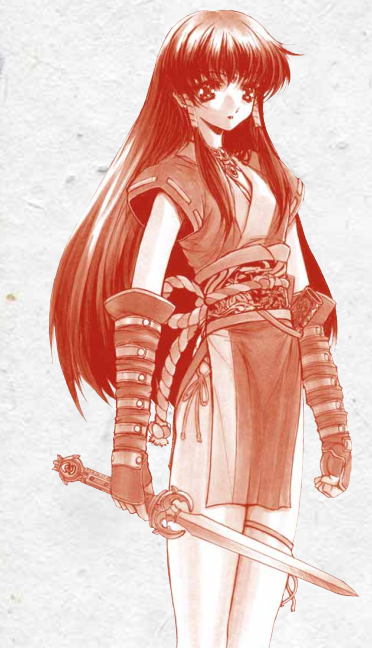
... and after.
Kugutsu-Makers are the rare breed of onmyojutsu sorcerers who dedicate their life to creating Kugutsu. As it can take up to a decade to create and train a Kugutsu, this profession only attracts pure artists, not people who are out for money - though they can surely make quite a lot of money. Because of their high demand and low supply, Kugutsu can be safely assumed to be the single most expensive "items" on Tenra money can buy, especially those of famous Kugutsu-Makers.
The most legendary of all Kugutsu-Makers is Shou-un , who is known for three things: Nobody knows his identity or even gender, he has apparently been making Kugutsu for 200 years, and his creations are known as the War Brides because lords will do anything to get one, including starting a war.
As it is typical for artists, Kugutsu-Makers tend to have their own little quirks: Some train their Kugutsu in a martial art or sorcery to become Blade Princesses that can also double as a bodyguard, others might add deliberate imperfections like blindness to their creations, and some even create male or androgynous Kugutsu. They can even allow the Kugutsu to age naturally, which comes in handy for Kugutsu mean as body doubles, or Kugutsu that the maker purposely sets free in the world to live as a real human being.
The Butterfly Dream
Their origin as sacred tree mannequins still infused with tree spirits allows them to see and control dreams. This ability is known as the Butterfly Dream . They can make people fall asleep and enter their dreams, which makes them very useful for lords suffering from nightmares.
In terms of game mechanics, a Kugutsu can force a target into the Butterfly Dream with a contested roll (the Kugutsu's skill depending on whether she uses performance or seduction). This creates a new Scene with only the Kugutsu and its target. No one else can enter, but other players and NPCs might act as dream figments.
Aside from only being usable once per combat, the Butterfly Dream is very vaguely-defined and open to roleplaying. And it's a got excuse to borrow from Satoshi Kon movies.
Next Time : Annelids - Crawling in my skin; These wounds, they will actually heal.
Annelidists
Original SA post Tenra Bansho Zero
So apparently these guys are based on a more obscure ninja archetype I haven't come across before this book because I'm a weird kid who has yet to watch Ninja Scroll. Though I presume Blade of the Immortal goes a bit in this direction.
Annelidists
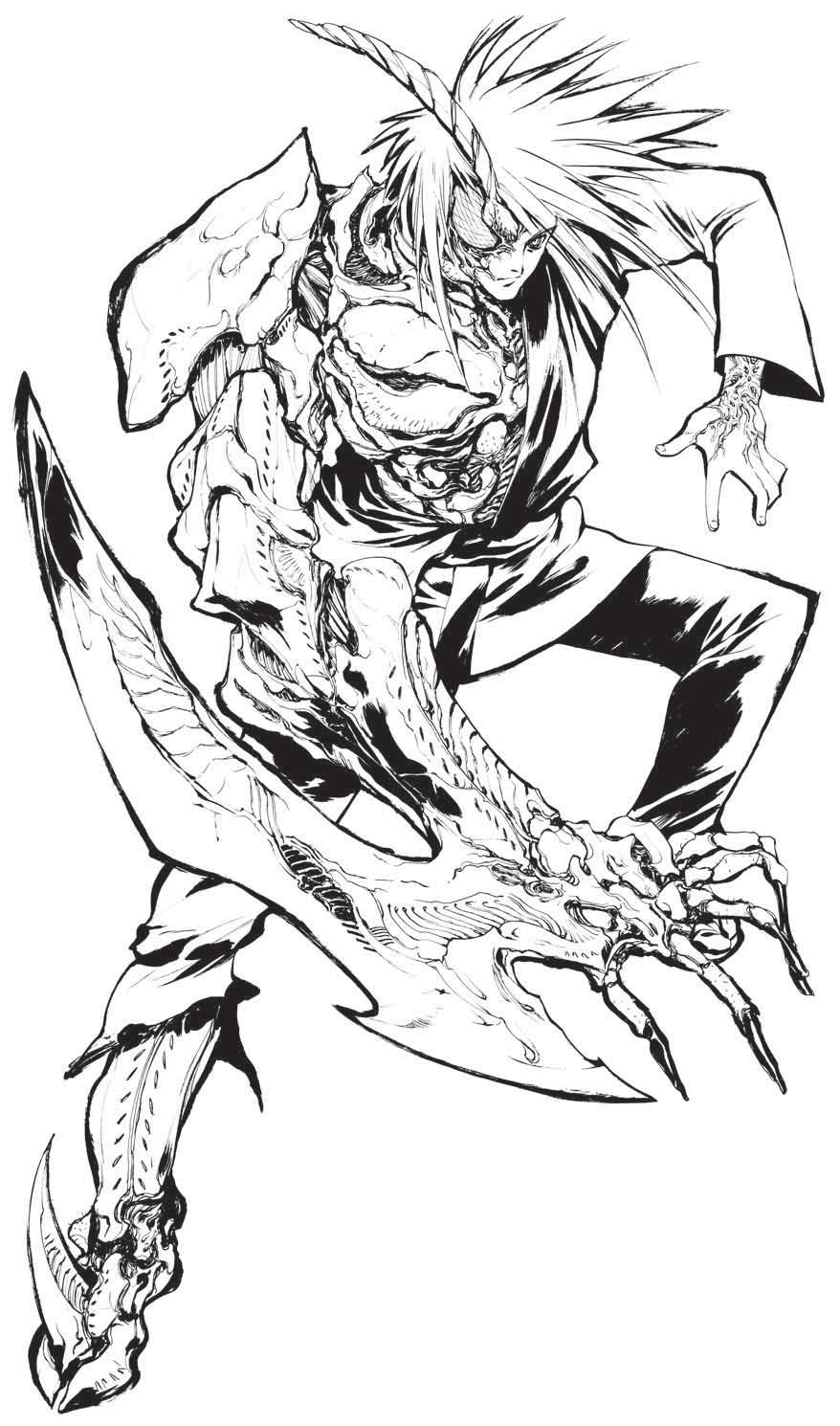
Kamen Rider Double Cross
Annelidists (aka "Annelid-users" aka "worm-users" aka "mushi-tuskai") are the witches of Tenra: Their medical knowledge and healing abilities are a boon to any villagers who doesn't want to die of infection or disease, but superstition and fear typically makes them outcasts living at the edge of town (or probably outside the town). In the villagers' defense, this is a bit more justified because Annelidists are incredibly gross and creepy to an outsider.
What makes them creepy and cross? Well, they live in a symbiotic relationship with Annelids , members of a very big and diverse family of parasitic worms and bugs. In exchange for being well-fed, they hang out under the host's skin or deep inside his body and defend him if need be. As if having worms visibly move around under your skin doesn't make you enough of a freak, the different types of Annelids each require a specific diet. This can be simple stuff like "lots of fruit" or "just eat more than normally", but some Annelids require the host to eat earthworms, blood or rotten meat. This leads ot obvious slurs like "corpse eater".
Not caring enough about your Annelids will have them leave your body, but going to far and having more Annelids than you can handle can easily turn you into a mindless, walking bug colony.
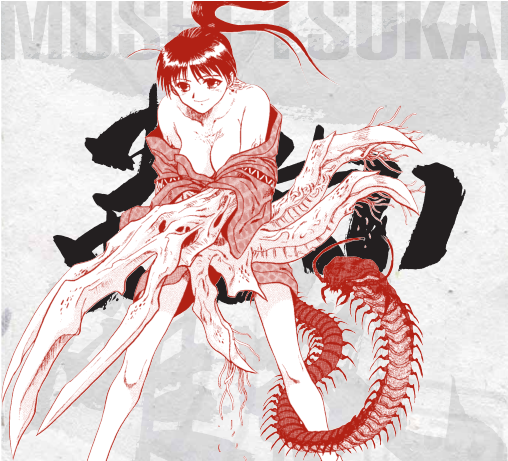
This date is turning out weird...
As they have a hard time fitting into normal society, many Annelids live in secluded communities known as Nests where they can breed and research Annelids to their hearts' content. Mad-scientist-types are harshly punished, as no Nest wants a repeat of a certain event were one Annelidist essentially turned himself into John Carpenter's The Thing aand nearly wrecked a whole kingdom, leading to a dark age of Annelidists getting massacred out of fear.
Annelidists in urban areas generally have it better than their villager comrades because of the greater anonymity. They make a living by selling basic Annelid knowledge to martial artists and other warriors.
A typical background for a PC Annelidist is that of the Peddler , a wandering Annelidist pharmacist who doesn't get into troubles with the Nests he comes across as long as he pays them some money.
Annelids
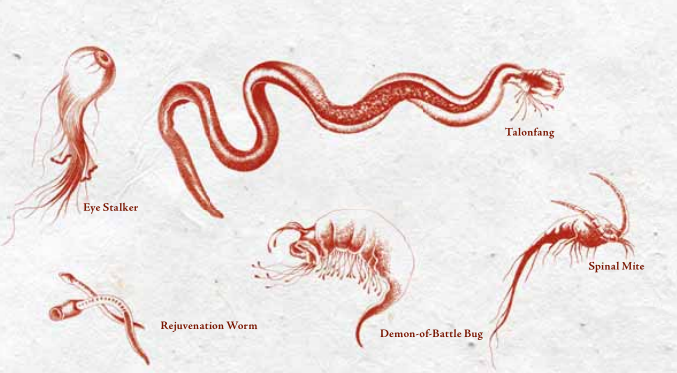
Your new BFFs
Having parasite BFFs requires having the Wormcharm skill (which also have to be rolled for a lot of Annelid abilities, like any attack they grant you) and paying for the Annelid(s) with Kiai or Karma.
-
Blackwing
: A bug that hangs out in a chrysalis on your back. If you want to fly, it'll burst out and carry you, though it isn't particularly fast. Its low lifespan also limits its use to one time per act.
-
Blood Hulker
: These cute critters can act as additional muscles on command, greatly boosting the host's strength while reducing his agility (because they aren't really for precise manipulation).
-
Chitinshells
: These Annelids build chitinous webs inside the host, which not only increase his Vitality, but also allows him to be Spider-Man - if Spider-Man could also use his webs as tentacles.
-
Corpse Puppeteer
: A spider you can send into a dead body's brain to turn it into a what is essentially a zombie. Probably not something you'd really want to use as a good guy.
-
Crimson Poisoner
: A bug hanging out inside your brain doing nothing other than producing poison for other Annelids or your unarmed attacks.
-
Demon-of-Battle
: The most expensive of all Annelids at a whooping 80 Kiai/Karma (where most others stay in the single digits). They hang out inside your skull, and when shit hits the fan, they will pierce your skull with antennae to gobble up the surrounding Sha energy and mutate you into a half-insectiod rage monster. Your combat abiilities are boosted to a degree that can give Samurai a run for their money, and you gain some neat natural attacks including claws, acid spit and an electrostatic cannon. The downside of all of this is that the host must succeed at a Willpower check to avoid the Annelid from going completely berserk and trying to kill everything in the vicinity.
-
Digger Wasps
: Gives you a wasp colony who turn you into a hunchback and act as a poisoned ranged attack.
-
Dissolver
: This guy hangs around in your previously strengthened stomach, making its acide so potent you can spit it at Armour and have their armour melt off.
-
Eye Stalker
: Look suspiciously like eyeballs and can in fact be used as such. They burrow into any part of your body and can be detached for spy duty. Gross.
-
Hundred-Faced Worm
: Flat-like a stingray, these guys can be put on another person's face to turn into a perfectly-imitated mask that you can wear.
-
Immortality Strain
: Blade of the Immortal worms. The second-most expensive Annelid at 50 Kiai/Karma. Implanting one is incredibily dangerous and has an actual chance of killing you, but the result is that you can shrug are basically immortal. Any wound you suffer will heal either instantaneously or in a matter of minutes. Even the Dead Box. You only really die truly if someone chops your head off, burns you to a crisp or finds a poison that can get rid of the Immortality Strain.
-
Itami Strain
: These shut down your pain receptors for an improved Vitality score calculation.
-
Mindglower
: Small glowing jellyfish living in your finger. Release them for some light or have them zap your for improved concentration.
-
Mouth Creeper
: A giant friggin' centipede that can come out of your mouth to bite people. The attack itself isn't spectacular, but it has an ever so slight chance of paralyzing the target thanks to its poison.
-
Mynah Bug
: These bugs can perfectly copy any sound they hear. Use the together with the Hundred-Faced Worm, and you can become a doppelganger.
-
Rejuvenation Worms
: These very popular worms create a pool of points with which you can heal yourself and your allies.
-
Spinal Mites
: These can pump your body full of neurotoxins. This boosts your reaction speed, but poisons you afterwards.
- Talofangs : Another favorite. Despite their name, these are actually more eel-like critters that can burst out of the hosts limb and harden themselves into blades. Skilled Annelidists can greatly boost the damage output and even have them shoot out needles.
Next Time : Oni - Dances with Ayakashi.
Oni
Original SA postIn Tenra Bansho Zero, mechanica aka cybernetics do eat your soul, but so does everything else if you don't change or adapt.
Tenra Bansho Zero

There's some North America in my Feudal Japan.
Oni
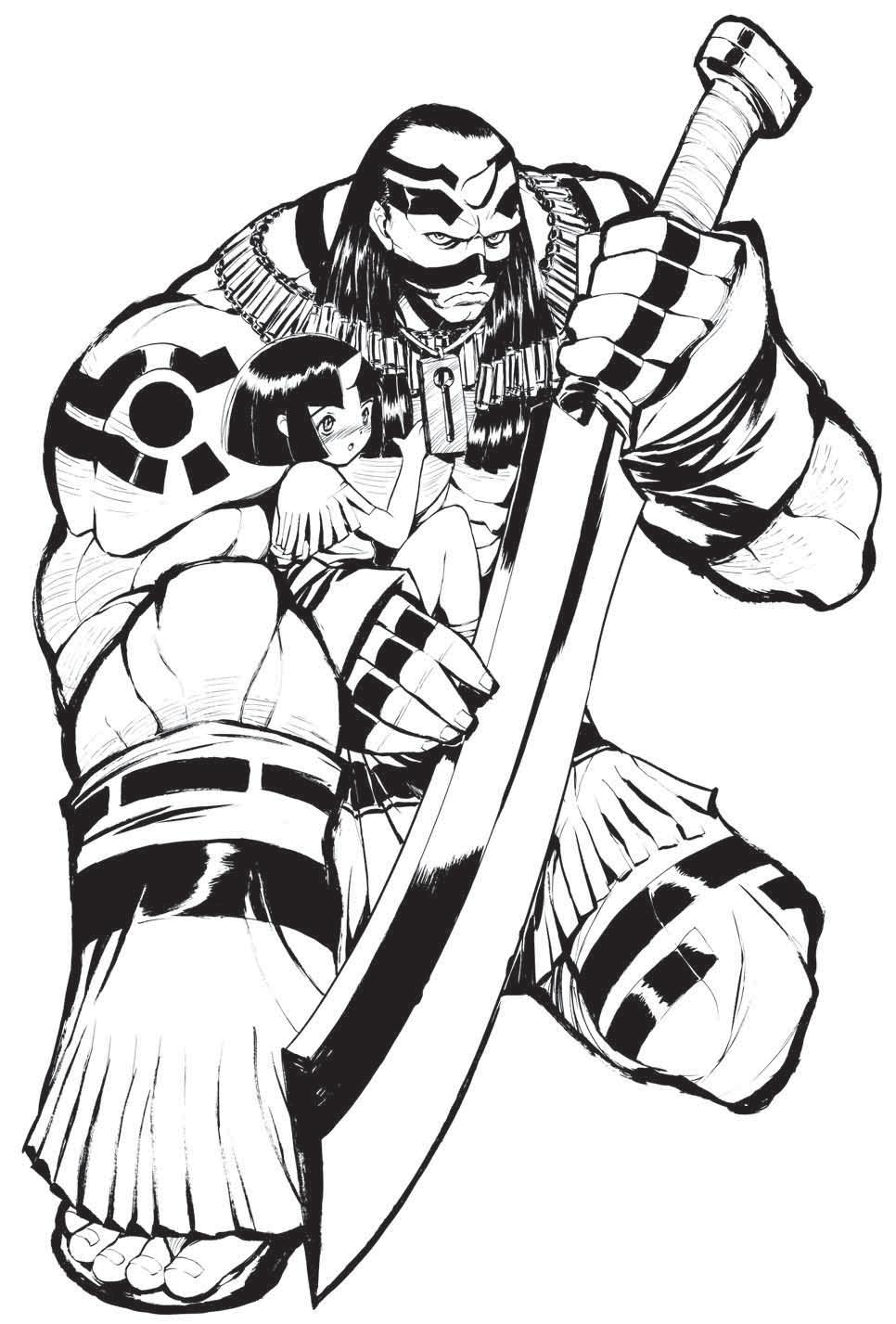
Japanese Rob Liefeld knows how to draw feet.
Oni are the native race of Tenra. They are visually indistinguishable from a human aside from the 1-2 horn growing on their foreheads (which gave them their human name) and have a strong Ainu / Native American theme going on, with the latter being the more dominant one (they even live in tipis).
Like with the Native Americans, the human colonists of Tenra didn't wait long to fall into the real-life murder hobo shtick of "Kill the natives and take their land" - which is especially dickish seeing how Oni welcomed them with open arms.
The murder hoboism went into overdrive once the humans discovered that Oni hearts are roughly spherical gems that continue to provide an endless supply of energy even after the Oni has died. Encased in steel, these gems have become the
Heart Engines
that keep Armours and Kongohki operational. With both now being mass-produced, the demand shot through the roof, bringing the Oni that much closer to extinction.
Mind you that the general human population doesn't know about the true nature of the Heart Engine. People just assume they are named that way because they act as the "heart" of the Armour/Kongohki. Lords and of course the Priesthood do know the truth, and they have spend several generations propagating the image of Oni as fiendish man-eaters who are just one of the many monsters on Tenra. Villagers are therefore more than willing to report any Oni village they discover, so the brave lord can rally troops and mercenaries to harvest some hear... err, I mean free the villagers from this menace.
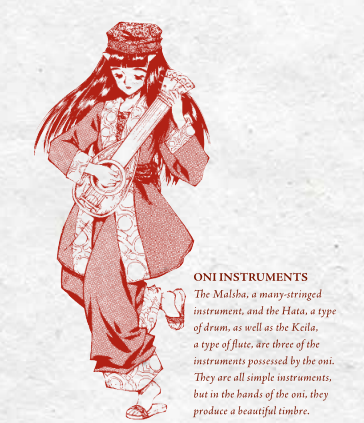
Run for your lifes! She will eat us all!
While Oni are individually stronger than a human and can live up to 1,000 years, they have never been as numerous as humans, and female Oni only become pregnate every couple decades. Not to mention that they don't really have anything of use against massed gunfire. Or giant robots and crazy fast killbots fueled by the hearts of their fallen.
With this grim outlook, Oni either live in hidden village and have resigned to their fate, or they lead a desprate fight against overwhelming odds. Others actually cut off their horns and hide in human society, which is a high prize to pay for an Oni in more than one ways.
(And as a little creepy plot idea, it is theoretically possible for an Oni's soul to remain in his heart and eventually awaken...)
Faith
Oni are known as the
Lu-Tirae
in their own tongue, which means something along the line of "supervisor" or "caretaker". This is because their god
Yi-yil
or the God-Who-Left created them to watch over Tenra while he is away somwhere in space, or maybe another plane of existance.
While he is gone, another being known as
Dii-go
the Earth-Speaker (who is apparently somewhere inside of Tenra) acts as Yi-yil's voice and messenger, speaking to the Oni through their heart gems. This has made the Oni quite spiritual, and they like giving themselves body tattoos using variations on the simple geometric glyphs representing their little pantheon (they don't have an actual alphabet).
Still, the situation for the Oni is far from good, and Dii-go's voice has become muffled and pained over time, causing some of the younger Oni to ditch a faith that doesn't seem to be doing them any good.
Resonance
Resonance - also known as
Tae Rayi
- is the term used to describe the innate supernatural powers of the Oni, which all involve manipulating surrounding Sha energy. These powers can be split into
Alu
("heaven") which uses the horn(s) and
Dii
("earth") which uses the heart gem.
Alu
Oni horns aren't just for decoration. As a gift from Yi-yil, their horns grant them telephatic abilities. They can read mind and speak to others mentally. This power however is waning, and the Oni are no longer able to communicate entire telepathically like they used to in the olden days.
Nevertheless, this rudimentary hive mind resulted in the Oni not thinking of themselves as individuals, but as a collective. They don't even have first and second person pronouns in their own language, and their names are more like job descriptions than anything else. Still, the near-extinction and the culture clash with the humans has made more and more Oni become more individualistic.
Alu masters can also use these telepathic powers for mind bullets.
Dii
The heart gem of an Oni is his connection with the land of Tenra, granting him a form of telekinesis. This is pretty straightforward: You start out only being able to move a couple kilograms, until you're able to hurl small temples around. Dii Masters can also wreck Shikigami by absorbing the Sha energy that keeps them alive.
Special Tae Rayi
Every once in a while, an Oni is born with special Sha manipulation abilities that go beyond Alu and Dii:
-
Mighu: The Calm
: A healing spell.
-
Tse-Yi: The Cloak
: Creates an anti-magic zone that actively pushes out Shikigami and Samurai.
-
Ejah: The Blinding Gale
: This lets an Oni mimic a Kongohki's Overdrive ability (aka more speed and power), though the strain will cause damage.
- Ku-Yau: Claws of Light : Attacks with a sword or claw made out of pure energy.
Half-Oni
Despite the hatred and propaganda, love does occasionally bloom between Oni and human, creating these offsprings.
There isn't really a lot in the book about these guys, aside from the obvious "Has troubles fitting in any culture" stuff. I'd also assume that humans will try to kill them as they are hard to distinguish from Oni. They also seem to provide the only bishounen artwork in all of TBZ, which I'll safe for later.
Powerwise, Half-Oni have access to basic Resonance powers (though they do have a heart gem like a real Oni), but they are incapable of beeing born with the above special abilities.
The Makuu Nindo Revolt
After the schism, it turned out that things could become even worse for the Shinto Priesthood: An Oni monk of the Ebon Mountain sect going by his Buddhist name Makuu Nindo started a revolt in the state of Kikoku , which was not only the place on Tenra with the highest Oni population, but also the one where humans were the must sadistic.
With the help of a mysterious woman known as the Sleeping Girl who may or may not have been an incarnation of Dii-go himself, Makuu Nindo united the Oni - and even a couple humans who had enough of their lords and/or the Priesthood - to start a large-scale attempt to make Kikoku their own.
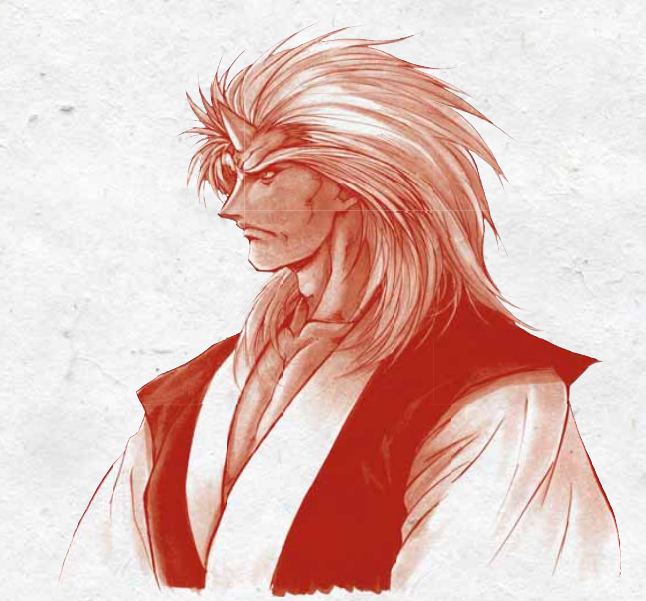
Just needs some Scottish face painting.
Greatly outnumbered and outgunned, it seemed that this revolt was short-lived - if it wasn't for the Two Month Night : Tenra's entire Sha flow just stopped without warning, leading to a massacre on Kikoku's forces as Armours and Kongohki ceased to work, Shikigami vanished and Samurai found themselves depowered. It's like an Oni-Waaaaagh.
To counter this sudden turn of events, the Priesthood sent one of their airships to blow the rebels to Kingdom Come. Unfortunately for them, an elite rebel team managed to capture the ship, resulting in one of the Priesthood's biggest blunder..
With Kikoku now in the hands of Oni, things are far from behing peaceful. The Oni and their human alliance still can't quite get over generations of bloodshed, the neighboring lords aren't exactly on good terms with them, and the Priesthood is apparently looking for a way to locate and nuke Dii-go's physical body because they really don't like people stealing their toys.
Next Time : The Shinto Priesthood - playing a dick. Also hacking.
Shinto Agents
Original SA post
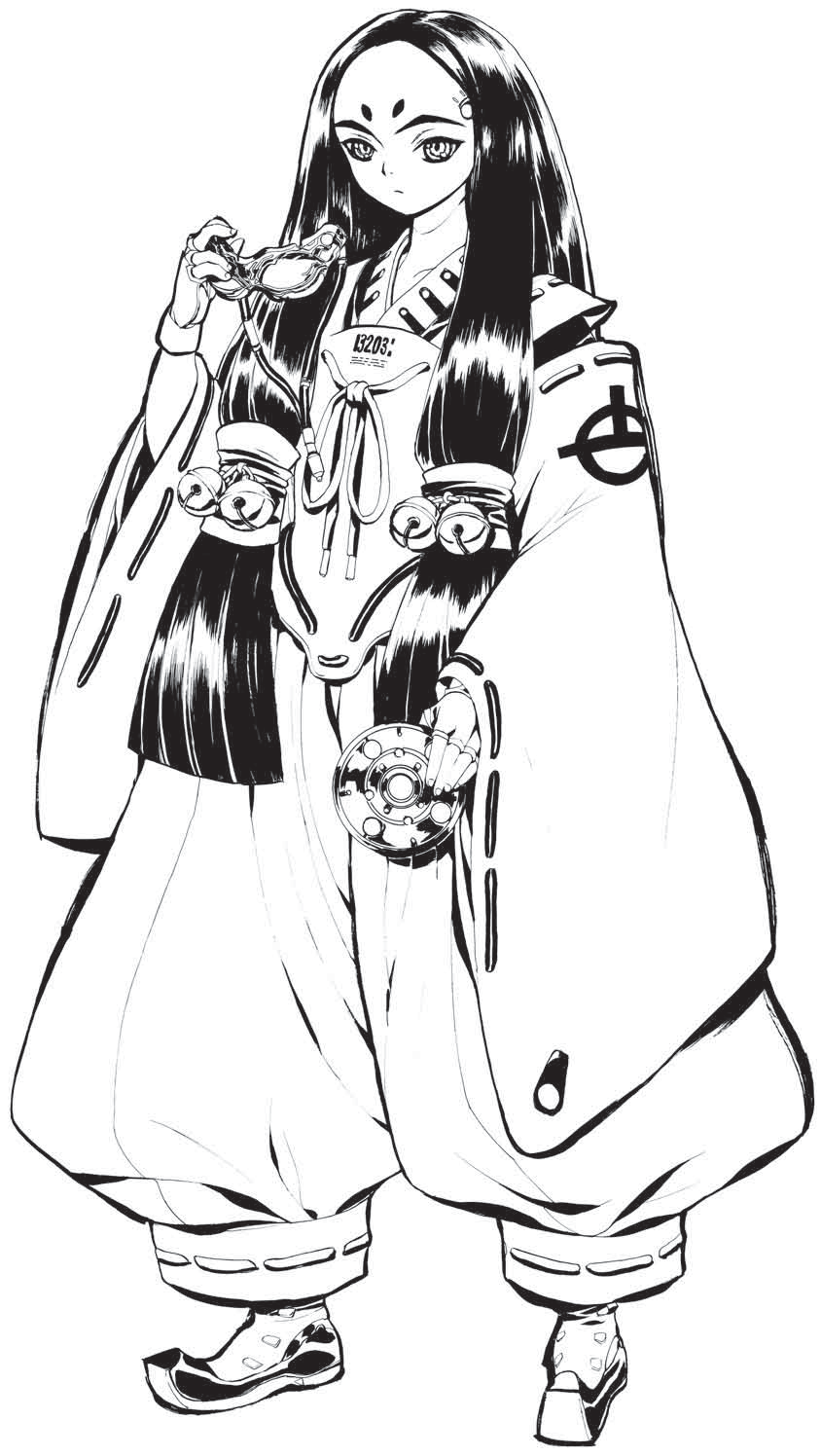
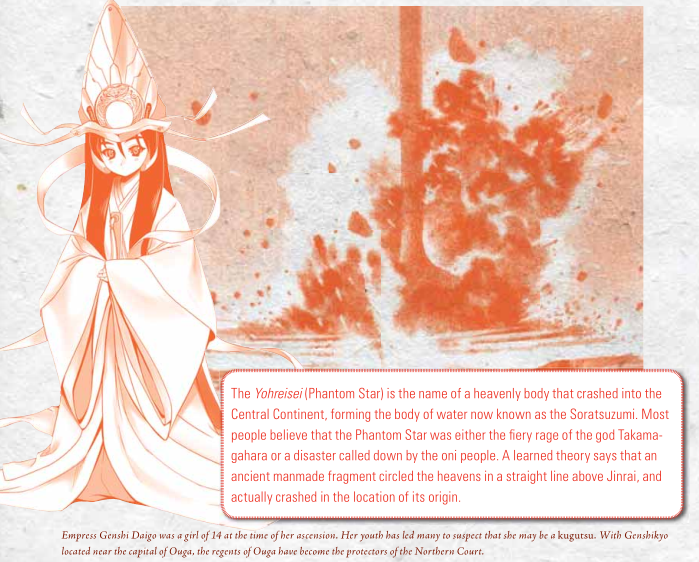
-
Summon Rain
: Allows the agent to change the local weather.
-
Worship
: Pray to the local shrine's kami to gain successes for later use. Also used for general worshipping, hence the name.
-
Omoikane
: Summons the help of the wisest of all Kami for scrying duty, allowing the agent to see and hear what is happening in another Scene.
-
Ara-Mitama
: The wild Kami of the land can be summon to essentially perform a wish that will be followed according to the agent's intention (skipping the annoying part where the GM tries to come up with loopholes in the PC's wording). The bigger the wish, the harder it is to succeed. There is barely anything the Ara-Mitama can't accomplish, and enough successes would even allow the agent to travel back in time or perform a resurrection. This is also the only ritual with a limited number of uses per scenario (unless you're a Bu-ranked agent, then you can go wild).
-
Mishaguchi
: A tree Kami that summons a small tornado centered on the agent that acts as an impassible and imprenetrable barrier.
-
Amatsumikaboshi
: The most evil of all Kami can completely destroy one square kilometer worth of urban area. PCs and NPCs with plot armor are immune to this effect.
-
Arahabaki
: The pre-Shinto god Arahabaki himself performs some divine smiting, striking a single target with a bolt of lightning. It's like a
Magic Missile
in that it never misses, but it is a lot stronger. The damage depends on the agent's skill rank and Spirit attribute, with Bu-rank agents capable of dishing out hundreds of points.
Ayakashi
Original SA post Tenra Bansho Zero
I think you can use these rules for superheroes.
Ayakashi
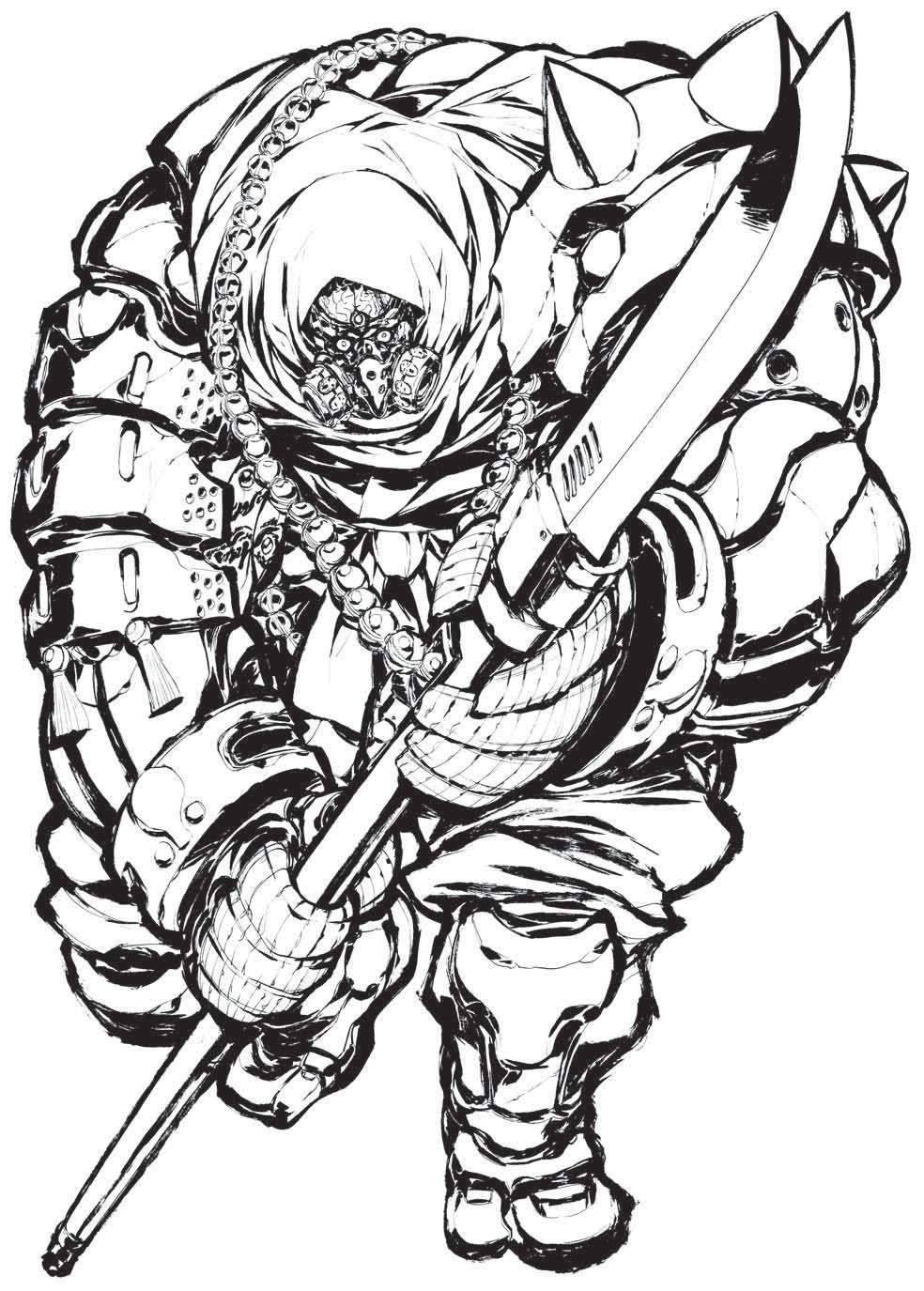
My face is a gas mask full of tiny faces.
Ayakashi are the supernatural beings of Tenra. They come in all kinds of sizes and forms. Some a fey-like, other demonic or downright Eldritch. Some might be gentle creatures full of wisdowm, while others are dangerous beings that only think of destruction.
To bring a bit of order into this chaos, humans have come up with 4 general categories of Ayakashi, though many Ayakashi can be quite hard - if not downright impossible - to clearly define. This is reflected in the Ayakashi creation rules, where the only difference between the categories is their maximum power level.
Incidentally, almost all of these category titles make great names for World of Darkness games.
Henge: The Different, The Transformed
Henge are the go-to category for most Storyteller System PC options, as they used to be ordinary animals or humans until something happened to them, making them larger, smarter and often with animal/man-hybrid features. They're your bakeneko or nekomata (aka cats that became monsters when their tail kept growing and/or split into two), and even some Kijin or Annelidists could technically count as Henge. Orochi is also classified as a Henge.This is also a good category for making a mutant human, if you feel like playing as the Toxic Avenger.
The example Henge provided by the book is the Chimera , which is what happens if a Shikigami goes rogue and becomes a twisted, soulgem-covered rage monster, which is especially problematic if it was bound to a Heart Engine and can now exist indefinitely.
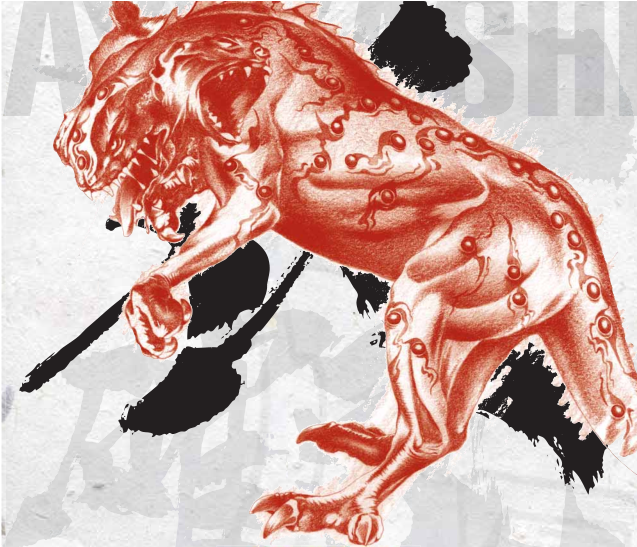
It's like The Thing in mid-transformation
Tsukumo-gami: The Artifacts
Based on the Japanese superstition of objects or even entire places gaining a soul and slowly becoming sentient over time. A Tsukumo-gami's soul can also be from a human, somewhat similar to a Kongohki.
As being an animated object isn't freakish enough, Tsukumo-gami have a tendency to sprout faces and/or a strangely organic look.
The two examples for this type of Ayakashi is the Wheel of Flame (an oversized Armour greatsword of a Rider that went berserk that now occasionally joins in battles out of sheer bloodlust) and the Daidara-Bocchi (derelict Armours who have gained sentience and sometimes act as benevolent giants).
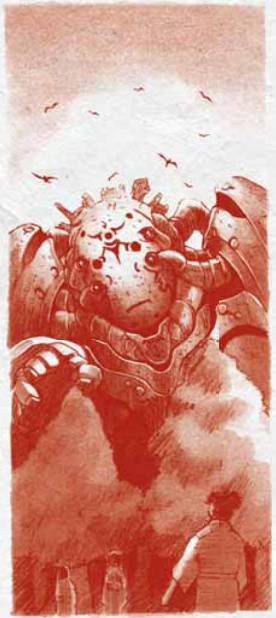
What's that over there?
Yokai: The Monstrous
These are what most people on Tenra think of when they hear the term "Ayakashi". Having a much more narrow focus than the Yokai of Japanese folklore, they are vengeful ghosts, losts souls trying to share their suffering with the living, or just beings born of pure hatred against mankind.
While most Ayakashi have strange, alien motives and goals humans have a hard time wrapping their heads around, Yokais are plain and simple: They just want to torment and/or kill you.
The example Yokai* are the Tengu , which in TBZ is a pretty metal thing with psychic abilities and blade wings that may or may not have once been a fallen monk.
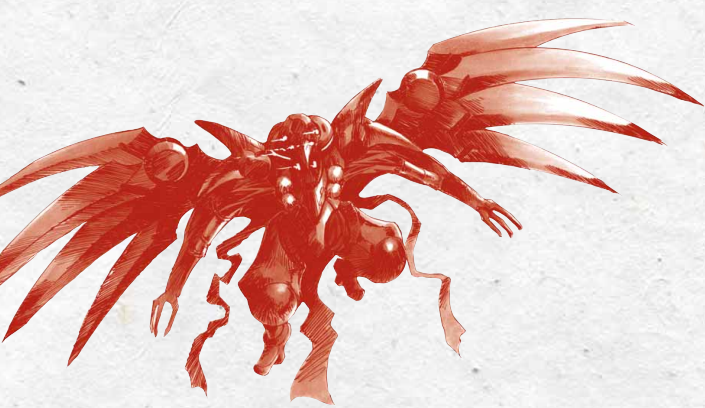
It is also extremely hard to make sense out of their face, or head for that matter. It's almost like gazing at Azathoth.
*) I think. The book doesn't really spell it out. They do however don't appear to be evil, so they might actually belong to the next category.
Ara-Mitama: The Deep Spirits, The Gods of the Wild
The most powerful Ayakashi are actually lesser, earth-bound gods (or close enough in power that it really doesn't make a difference). Think of all the non-humans in Princess Mononoke or Spirited Away (with the possible exception of No-Face who is more Yokai-ish).
Some Ara-Mitama can be beings of pure evil, but many acts as guardians for the region they live in.
The example Ara-Mitama are the Great Wolves , who are like the Oni in that they have been ordered by Yi-yil himself to watch over Tenra. They tend to appear in places where the natural balance of the world is in danger.
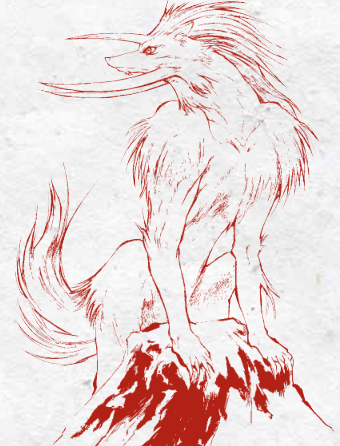
Let me tell you about my fursona...
Humans and Ayakashi
While human horror stories tend to pain Ayakashi as the aggressors (which does tend to be true for Yokai), most Ayakashi-related problems actually start when humans just barge into their turf, or when the Ayakashi is awoken - or actually created - from all the death and misery created by all the grim darkness going on.
Once enraged, an Ayakashi tends to go berserk for quite a while, forcing the local lord to send some troops to deal with the threat. This only really works for weaker Ayakashi and never for Ara-Mitama (who can curbstomp entire armies on a regular basis), especially since Ayakashi can't be truly killed if you just destroy their current body.
What you need for serious Ayakashi problems are Spirit Hunters , Buddhist monks trained onmyojutsu. To wipe a Ayakashi out both physically spiritually, they have to study it. Learn of its goals and weaknesses. This can be quite stressful to a human's psyche, and Spirit Hunters have a tendency to go a little bit crazy.
A recent trend - probably another result of grimdarkness - are spirit packs , hordes of very weak Ayakashi that nevertheless pesker the locals and have a tendency to attract larger, more powerful Ayakashi.
As some Ayakashi look quite human or can at least take on the form of humans, Half-Ayakashi are occasionally born. They are humans with strange powers, and usually do their best to hide their true nature because they don't feel like getting a visit from a lynch mob carrying torches and the pitchforks.
The book notes that Ayakashi should never be used as mere cannon fodder. That's what Ashigaru are there fore. Ayakashi should be treated like monsters from a Sword & Sorcery story: Strange, alien creatures that are very rare and are always the main focus of any story involving them. Spirit packs in this case probably count as a single creature.
Ayakashi Creation
Ayakashi are created slightly different depending on whether they are NPCs or PCs.
NPC Ayakashi get an allotment of points to spend on attributes, skills and powers called Yohjutsu (from the "yoh" character used in the Japanese writing of Ayakashi). The maximum number of points depends on the category of the Ayakashi, with Ara-Mitama having a much higher upper limit than anything else.
The book is sadly not exactly clear on whether you have to spend points for every single skill or just assign a single rating for all skills that make sense for the Ayakashi. Most of the example statblocks just go "all skills at x", which becomes ridiculously expensive fast and downright impossible to do within the point limit.
Doing a bit of reverse-engineering, it appears you just buy one ranke for all skills. Then again this is all just for NPCs, so the GM can just give them whatever stats and powers he wants. This approach also makes sense seeing how this would be the only case of NPCs having a clear upper limit.
PC Ayakashi and Half-Ayakashi are just built like normal characters, with the option of buying powers with Karma.
Yohjutsu
Ayakashi powers are similar to skills in that most of them have a rating from 2 to 5. The GM is free to tweak the power's effect if it doesn't quite make sense for the Ayakashi in question. So just because an attack power allows attacks up to 1 kilometer doesn't mean it has to.
-
Domination
: Mind Control with varying levels of obedience.
-
Draining Weapons
: Damage-over-Time attacksl like poison or acid.
-
Fear
: A bit like in Warhammer. Max level allows the Ayakashi to freak out an entire city.
-
Flying
: Higher levels increase the speed and maximum carrying capacity before getting encumbered. Top speed is Mach 0.5.
-
Hallucination
: Mess with people's perceptions. Powerful Ayakashi can create illusions that last forever.
-
Healing
: Actually more like regeneration, as it heals Vitality each round.
-
Incorporeal
: Allows the Ayakashi to move through solid objects. No immunity against physical attacks though.
-
Invisibility
: The higher the level, the longer the Ayakashi stays invisible, until it becomes permanent.
-
Mindreading
: Powerful Ayakashi can not only read you like a book, but you won't even notice that he does.
-
Multiple Forms
: Like the ninja duplication trick. Max level can make 10 copies, or one perfect copy that is just as powerful and sturdy as the original.
-
Natural Weapon
: Claws or teeth and stuff. Tsukumo-gami with this are also typically animated weapons.
-
Possession
: Take over the target's body. The book helpfully points out that the GM shouldn't min-max an Ayakashi to be a dick to the PCs with this power.
-
Projectile Attack
: All kinds of Pokemon-esque ranged attacks, from lightning to needles.
-
Resistance
: Armor and/or thick hide for extra Vitality.
-
Shapechange
: Play doppelganger. The higher the level, the longer the Ayakashi can maintain his disguise
-
Superspeed
: The Ayakashi either gains the Kongohki's Overdrive ability or a kind of Super Overdrive that allows the dice to explode a second time. Ouch.
- Undying : Like Healing, but for the Wound Track.
Weaknesses
In order for Ayakashi (both NPCs and PCs) to gain more points to spend, and to offer an interesting option to defeat the Ayakashi, it is highly recommended to pick at least one Weakness.
Weaknesses come in three flavors: Taboos are things the Ayakashi is not allowed to to (like revealing a kept secret for Tengu). Tricking an Ayakashi into breaking its taboo will cause damage, up to instant death.
Vulnerabilities are things the Ayakashi is particularly weak against, causing the damage to be multiplied. An example is the Chimera's vulnerability against other Shikigami.
Goals are the Ayakashi's motivation, its reason for existing. The level of this weakness determines how serious the Ayakashi is at accomplishing the goal. Max level means the goal is so important to its core being that it will be instantly destroyed if it acts against it. Such an exmaple is the Great Wolves' determination to guard the lands of Tenra.
Any damage sustained through a weakness is of course unaffected by whatever regenerative ability the Ayakashi has.
Next Time : Arts of War - my Kenjutsu is better than your Kenjutsu.
Arts of War
Original SA post Tenra Bansho Zero
Arts of War
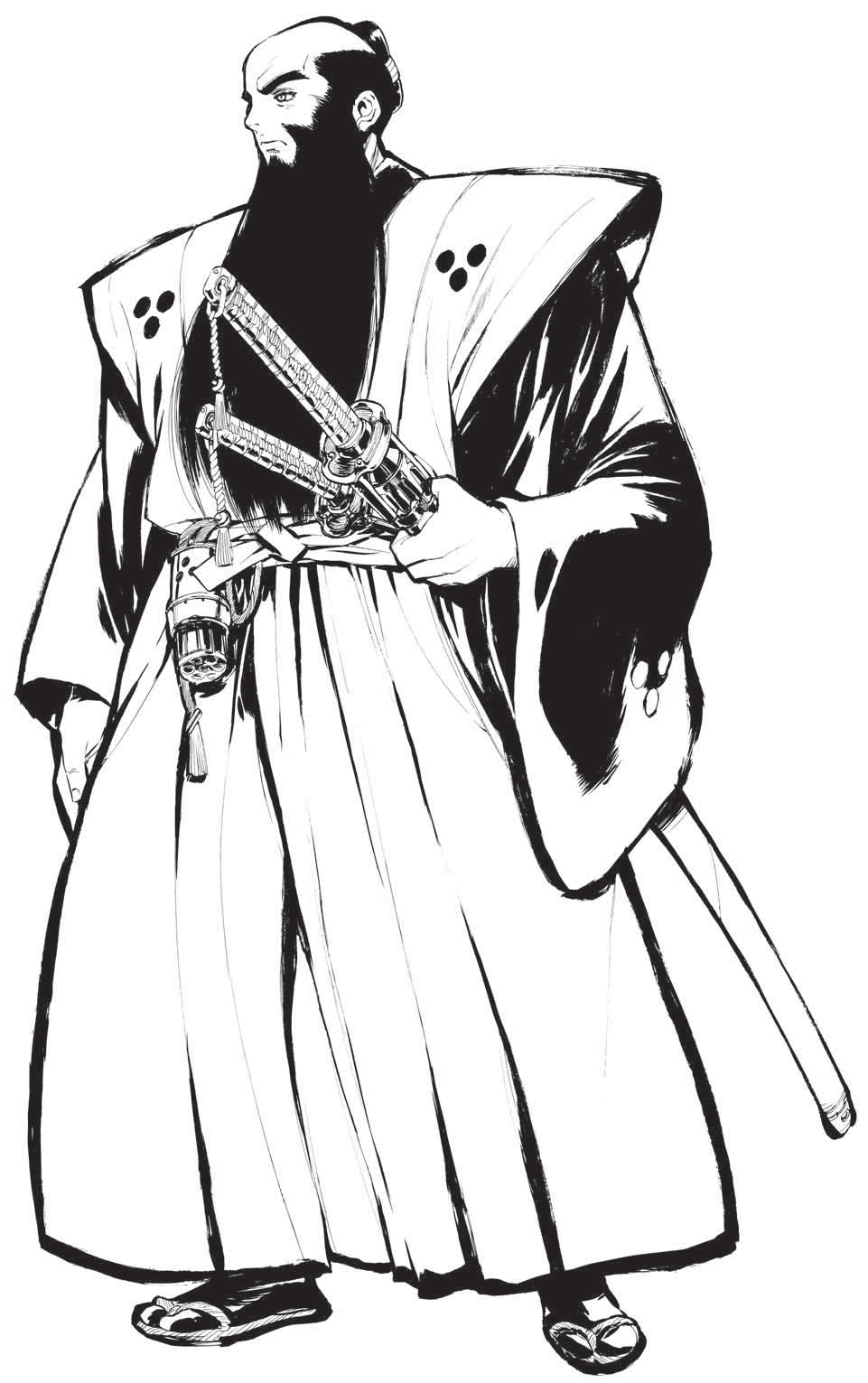
That's one majestic beard.
Arts of War - like Buddhist martial arts - are the different fighting styles teached throughout Tenra. They are bought like skills and provide a new (mostly passive) technique each rank, like a feat chain.
While a character can learn multiple Arts of War, he can't combine techniques from different ones for a single action, as they generally require completely different stances, ways of thinking etc.
Armour Riders can make use of their Art(s) of War while inside their giant robot, but they cannot replace the corresponding combats kill (Melee, Unarmed or Marksman) with their Interface skill because you actually have to be good at using the Art personally.
A general trend with these Arts of War is that they allow you to use a different Attribute for you combat skill roll than what you would normally roll. This is typically the first technique to be learned, and all the following techniques require this replacement Attribute to be used.
Also handy is any technique that lets you make counterattacks against ranged attacks, as those rob Ashigaru and other cannon fodder of their only safe way of attacking you.
As having a strong army is imperative in the world of Tenra, every lord worth its salt employs at least one War Master , a powerful practicioner in an Art of War serving as the army's trainer.
As the lords don't want to lose these valuable assets (and the assets themselves don't see getting blown to bits by giant robot artillery as a particular fair and honorable way to go), many masters in the Arts of War avoid actual battlefields and instead compete in Royal Tournaments for fame and glory.
Fun fact: Tenra's Myiamoto Musashi is called Koan Hajime (the artist formerly known as Karasuma Shiro), and his "Book of the Five Rings" is called "The Analects of War".
Southern Seas One-Blade Style (Kai-Nan-Ittou-Ryu)
Invented by a particular suicidal samurai and honed in actual battle, this style is all offense, zero defense. For a user of this Art, there is only his blade and its target.
Aside from being able to use Body instead of Agility for all Melee skill rolls (as this style is all about overwhelming the enemy), this style mainly boosts the user's Aiuchi attack, that full-offense counterattack where you deal full damage to your opponent if you can survive him doing the same to you first.
As you gain ranks in this Art, you will be able to force the defender into doing an Aiuchi attackand still be able to land your hit if you get knocked out (for those "Two fighters dash past each other, stand dramatically for a moment, then one of them collapses" moments). Real masters strike so fast that they land their Aiuchi strike first. Unless the opponent also has this Art or the user rolls particularly poorly, this is essentially an insta-kill for lesser opponents that don't have enough Vitality to take a hit. Pretty handy when dealing with ninja and other quick dudes due to the auto-hit properties.
Clarity of Heaven Style (Ten-Shin-Gan-Ryu)
Invented by a Bright Lotus monk who wanted to defeat his opponents without killing them. His solution was to specialize into hitting their limbs.
As this requires a very good aim, this style allows you to use Senses instead of Agility for melee combat. By first learning how to accurately hit the oppoent's limb and later his Chakra points, you get to decide how the opponent distributes his damage between Vitality and the Wound Track (though the Dead Box is out of the question). A master can damage or outright detsroy the opponent's weapon.
True Illusion Style (Shin-Ei-Ryu)
Founded by an onmyojutsu assassin, this style focuses on speed, decepting and trickery, using Knowledge instead of Agility.
As trying to confuse the opponent can backfire badly when it doesn't work, this style's gimmick is that whoever hits doubles his margin of success. A master of the True Illusion Style can manage to confuse Death himself, allowing them to delay the actual effect of their hits for up to 3 years. Imagine telling a campfire story about how that one guy almost decapitated you a few years ago, only for you head to suddenly fall off your shoulders.
Empty Mind Style (Gashin-Kikuu-Ryu)
The obligatory iaijutsu style. Users of this Art keep their weapon sheathed until the perfect time, at which they strike with blinding speed and then sheath their weapon again, never allowing the opponent a chance to see the blade.
As this gimmick requires great spirituality and a certain state of mind, you can replace Agility with Spirit.
As you only strike or defend at the last possible moment, this is essentially an even more risky version of the True Illusion Style: Whoever wins gets to keep all of his successes for damage calculation, effectively granting a free Aiuchi attack.
Empty Mind masters can use their pure will to attack, allowing them to turn their strikes into short-ranged attacks.
Dragon and Tiger under one Sky Style (Ryuuko-Itten-Ryu)
Of course did the above Tenran Musashi come up with a dual-wield style. This Art grants a damage bonus for wielding a secondary weapon in the off-hand, which improves with rank and eventually lets you add the full damage from both weapons together. This full effect doesn't work for counterattacks, but at least you are able to win ties by stabbing the opponent with your secondary attacks.
A true master can make one full attack with each weapon, either against two different targets or a single one (in which case you essentially attack with double the die pool). As this is a rare case of making multiple attacks outside of counterattacks and spending Aiki chits, this move not only costs a lot of Soul, but also breaks the two weapons.
Crescent Moon Blade Tactics (Tohoh: Kogetsu)
The chessmaster villain style, which lets you study the enemy's movement so well that you can predict his actions, using Empathy instead of Agility.
As you gain ranks, you read the enemy so well that you deny the enemy more and more defensive actions when you attack, until he can't do anything to reduce your successes aside form creative use of Annelidts or Oni Resonance. Pretty scary.
Migawari-Style School of Marksmanship (Migawari-Ryu Shageki-Jutsu)
No relation to the Imperial Stormtrooper School of Marksmanship, this Art was originally invented by the ninja of the Migawari clan to improve their thrown weapons skills, making it the first ranged Art so far.
Users of this Art can throw weapons with blinding speed, attacking with Agility instead of Senses and increases increases the weapon's rate of fire. They can even defend themselves against other projectiles with projectiles of their own, defending with the Marksman skill, without being able to counterattack, though - unless you reach the last rank, where you can defend and counterattack against anything by throwing some knives at it.
The Art of Ki Manipulation (Souki-Jutsu)
A style for both melee weapons and unarmed combat that involves chargin your attacks with ki. This effectively works like how you can improve gemblade damage by pulling the trigger, only in this case it works with any weapon and uses your own Soul points instead of soulgems. The higher the rank, the better the exchange rate. Overall a nice pick for those without use for their Soul (which is true for normal warrior dudes).
Fist of the Celestial Kongohki (Kongoh Rakan Ken)
This fighting style is exclusive to Kongohki (though I guess it also makes sense for Kijin so full of mechanica you can barely tell them apart from a Kongohki), as it takes advantage of them being able to move and twist their joints in ways impossible for a human being.
The first technique is the first one without any actual combat application. Instead, it allows the Kongohki to fly by spinning its arms, turning it into either a helicopter or the Tazmanian Devil.
Further ranks allow the Kongohki to perform instant surprise attacks through weird joint movements, surpass its limits, boosting its Overdrive (allowing the the dice to explode a second time, similar to Ayakashi Superspeed) at the cost of damaging itself. The final technique allows the Kongohki to blow itself up for massive collateral damage (and it can still survive somehow).
Though a lot of these techniques are neat, they really feel a bit out of place compared to the other Arts.
Resonant Blade Style (Zedai-Ryu)
A swordfighting style only used by an elite group of Oni known as the Zedaishu . Taking advantage of Resonance powers, it can only be learned by Oni and Half-Oni.
This style already start off promising by being able to summon a Sha-blade made out of pure light. Further techniques lets you spend Soul to reduce incoming damage or counterattack ranged attacks with your bare hands. The final technique lets you manipulate fate itself, giving you an Overdrive that works for everything, not just physical actions.
All in all, you're a Jedi in the Matrix. Or an Angel Halo / Orcus Overed.
Esoteric Arts of War
These are Arts of War that are rare, be it because they are near-forgotten, fallen out of favor or a bit unorthodox.
Ancient Style Lightning Strike (Kouryu: Senshou)
An old little Art that occasionally becomes forgotten, only to resurface later. Its main deal are lightning-fast strikes. You get to increase your damage (signifying your rapid-fire attacks) up to thrice your weapon's base damage if you master this skill. Other techniques use the familiar risk/reward trick of doubling the margin of success of the winner.
Typhoon Rider Style (Nohwake)
A very oldfashioned style about mounted combat, which is steadily losing relevance on the modern battlefield (aside from maybe guys with those freakish samurai horses).
The obligatory Agility replacement Attribute for this Art is Station, because riding into battle is not for dirty peasants.
The bonuses provided by this Art are pretty straigthforward and nice. You get a damage bonus for attacks on horsebacks that continues to grow until it is almost as ridiculous as Kenshiro's, and not only can your horse move over 100 m per round, but it can also eventually leap dozens of meters into the air. Pretty boss.
Seizan Mountain Spear Technique (Seizan Sohjutsu)
Speaking of dirty peasants, this style consists of a bunch of spear tricks passed down from one soldier to the next that have eventually been collected and formalized by a monk. It can be used with any polearms, as well as a nodachi (due to the length I guess).
Taking advantage of the weapon's superior length, users of this style gain a defense bonus, win ties with the opponent and pierce him in such a way he is forced to fill out his Critical Wound track before anything else.
The rare masters of this style can shoot energy bolts from their weapon.
Empty Fist (Kuuken)
A Kung-Fu-esque unarmed combat style focusing on using the opponent's momentum - and his own weapons - against him.
Aside form replacing Agility with Empathy, Empty Fist practicioners can use the useful - and very funny - trick of hitting the opponent with their own weapon. The "use his own momentum against him" part comes in your typical risky technique of "winner keeps all successes".
A master of this style can make himself appear so defenseless that he can draw aggro, forcing an opponent to target him.
Bestial Companion (Inugai)
Remember when I said that the Shadow School of ninjutsu lets you be Galford from Samurai Shodown? This unarmed fighting style lets you use a ninja dog in combat. Ninja. Dog.
User of this Art can communicate with their companion without speaking a single word. The dog himself is abstracted as a "ranged" attack. Further ranks let you deny the opponent actions by having your dog biting his leg, and you can eventually counterattack anything wiht Unarmed Combat thanks to your companion warning you from danger.
Black Wing Gun Style (Kuroba Yauchi)
A style born with the advent of gunpowder weapons, it focuses on dual-wielding guns, adding a certain Western flair to the game.
Like the melee dual-wielding Art, this lets you add more and more of your secondary weapon's damage to your main one. Further ranks also let you counterattack anythign with your guns.
Next Time : Within the Shadows of Tenra - secret organizations. May or may not be a multi-parter.
Within the Shadows of Tenra
Original SA post Tenra Bansho Zero
Tenran Anonymous is pretty badass.
Within the Shadows of Tenra
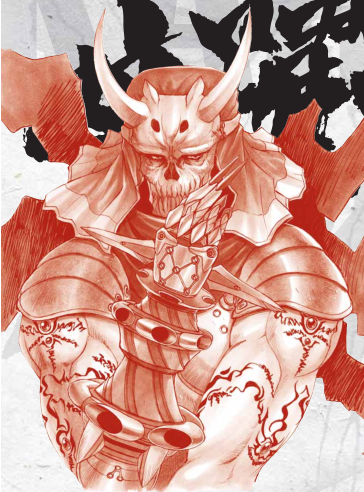
The new Spinning Blade Drill Arm (tm), brought to you by TBZ.
This chapter gives short summaries of various secret and not-so-secret organizations found in Tenra. Some have been mentioned before in the metaplot, while others only appear here. GMs are encouraged to ignore or modify them to their liking, particularly in regards to how good, evil or morally ambiguous their are.
Kimentoh: The Demon Mask Faction
The Kimentoh are a Tenra-wide secret society / terrorist organization whose name is derived from the rad demon masks its members wear to hide their identity.
The primary goal of these demon mask guys is to overthrow the Shinto Priesthood. They know that they are to few in numbers to attack them directly, so they opt for a combination of "Death of Thousand Cuts" and the Butterfly Effect: A bit of petty crimes here, some sabotage there, a few members in positions of power... and though these actions might appear unrelated and random at first glance, they all built towards the Kimentoh's ultimate goal and slowly but surely escalate into something big.
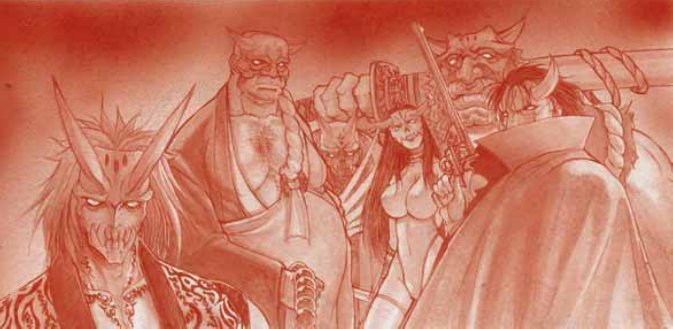
In the grim future of Bleach, there are only Visored. Man, is that manga still going?
As it is typical for secret societies, the people of Tenra have come up with all sorts of conspiracies, making them responsible for anything rom the Fall of the Phantom Star to the Makuu Nindo revolt (with Makuu Nindo himself also sometimes being made responsible for the Phantom Star).
What is true is that the Kimentoh are the first and biggest dealer of Kimen Kongohki technology, though this isn't common knowledge as they always act in secret. They of course make good use of these Kongohki themselves, rigging them with a self-destruct device to cover their retreats.
Kimentoh members fall into one of 4 categories: Cho (goons), Hei (cell leaders), Otsu (strategists) and Kou (SpecOps). Their secrecy goes so far that each member usually only knows the true identiy of the one who itnroduced him into the Kimentoh, and nobody knows the identity of their leader Kiyru Kouga, the Dragonfang (aka Spinning Blade Drill Arm guy). Though him being a Samurai Ninja Kijin (only one of which can actually be kept secret from the public) does decrease the circle of possible suspects ever so slightly.
What is their motivation? To they want to free Tenra from the shackles of the Priesthood douchebags? Or do they want to install their own terror regime and are just trying to eliminate the only threat standing in their way? It is for the GM to decide.
Kuze-Shu (aka Kuze Order)
The Kuze-Shu are an elite group of quirky specialists founded by the Phoenix Sect member only known as the Kuze Monk in order to protect the capital of Jinrai by any means necessary. They're part intelligence agency, part SWAT team, all under the order of the Priesthood.
Naturally, this originally mission got shafted when the Phantom Star fell and Jinrai and the surrounding land ceased to be, not to mention the Priesthood's schism. After lots of initial confusion and turmoil, the order decided to just split up, with the Blue Dragon Order protecting the Northern Court's capital, while the Adamantine Order did the same for the Southern Court. There's no real strife or anything, they just continue their old job.
The Blue Dragon Order is lead by One-Eyed Saikuro , a Samurai also known as the "One-Eyed Oni" because his Samurai form has him grow horns. The Adamantine Order is lead by Ran the Meikyo User , a special snowflake Shinto agent who doesn't wear a mask.
To act as a spiritual leader, the Kuze Monk had his soul sealed into a Meikyo mirror long ago, which Ran managed to duplicate so both orders could have their own mentor, with the Blue Dragon Monk being a Kongohki while the Adamantine Monk is just a mirror image/hologram.
The book presents a total of 18 Kuze-Shu members, and I have heard that most - if not all - of them are inspired by Marvel characters (particularly the X-Men), which probably explains the above soul clone shenanigans. Sadly my Marvel lore is limited to the movies, particularly infamous Spider-Man arcs and the silly characters from the Marvel Super Heroes "bestiary", so I'm not even trying to guess everyone's inspiration.
And if you liked TBZ's comic panels, I think most of the Kuze-Shu portraits where also made by the same guy.
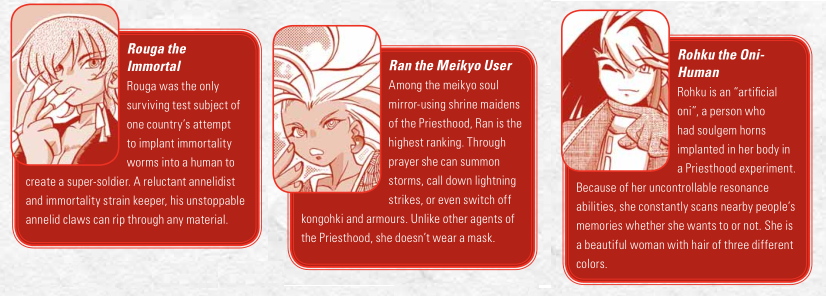
Wolverine, Storm, and kinda sorta gender-swapped Rogue (I think?)
Other honorable mentions go to Juubei the Half-Wolf (an Annelidist who has body-modded himself into a wolfdude, aka Beast), Keu-Lu (an Oni girl from the future aka FemCable) and Rei the Shrine Maiden (who is both a Half-Oni and a Shinto agent, whatever that is in X-Men terms). Not entirely sure why any sort of Oni-blooded wold work for the Priesthood, but I guess they must have their reasons.
There is also Tsuchigumo the Earth Spider , who is Spider-Man, right down to not actually being a member of the Kuze-shu/X-Men.
The Hidden 28th Chamber
As the Phoenix Sect spread over all of Tenra, its leaders quickly realized that having a purely defensive army is not enough to protect them from all threats. Some of them - like the Ayakashi - required more active measures to root out the problems permanently. Thus the most faithful of monks where recruited into The Hidden 28th Chamber of the Merciful Phoenix Sect, tasked with hunting down demons without and corruption within.
As their tasks include assassinations and other shady things that go directly against what the Phoenix Sect stands for, their very existance is denied by the sect an kept a closely-guarded secret. Monks recruited into the 28th Chamber are therefore officially declared dead and given a new identity.
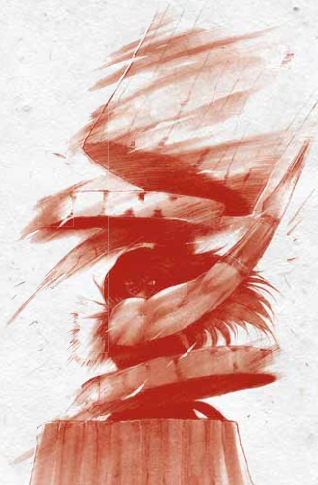
I always wanted to be a lumberjack.
While the Chamber itself stayed true and loyal to their mission of "Destroy the Enemies of the Buddha", its meaning has slowly changed over time to mean the enemies of the Phoenix Sect. Ebon Mountain and especially the Bright Lotus Sect have become victims of the 28th Chamber, and rumors say that they even attacked the Kuze-Shu, which would imply that the Phoenix Sect is starting to see their Shinto BFFs as a threat...
The leader of the 28th Chamber is Black-Red Sky, Monk of the Era of Corruption , a sorcerer monk and martial artist. Some of his underlings are slowly starting to question the path the Chamber has taken.
Zedaishu
The Zedaishu is an elite order of Oni and Half-Oni serving under Maikuu Nindo. Eager to finally have a land of their own again, they developed the Zedai-ryu (aka Matrix Jedi style) War Art that took advantage of their Resonance powers.
They played a vital role in the Makuu Nindo revolt, and they are currently busy protecting the Oni. Not just in their new land of Kikoku, but wherever humans are gathering for a new Oni hunt - which has become much more common thanks to the Kimenkyos.
The Zedaishu's leader is Sendou Anna , the only surviving member of the order's six founders, and pretty much the only piece of bishounen art in TBZ - which might come as a surprise considering TBZ appears to have a sizable female fanbase in Japan. I guess fanservice isn't everything.
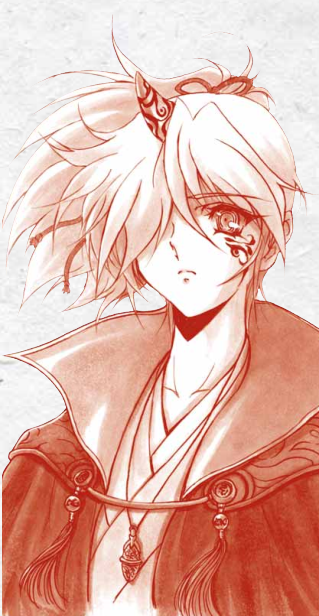
Equestria Shounen.
To prove that the Jedi analogue isn't a joke, there are the so-called "Zedaishu Stray", Zedai-ryu practicioners who refused to follow Makuu Nindo and have therefore gone against the will of the Oni gods themselves, branding them as outcasts. I bet their spirit blades are red.
The Hyakki Swarm (apparently an abbrevation of "The Hundred-Machine Ninja Swarm". Nice.)
Remember the part about Kongohki eventually remebering their previous life as an Asura and usually going crazy in the process? The Hyakki Swarm is a group of free Kongohki who not only stayed sane (or sane enough), but decided that being Chaotic Evil is pretty awesome. Acting as a mercenary army (and why would you not want to hire an army that is all speedster killbots?), they actually want to kill every living thing on Tenra.
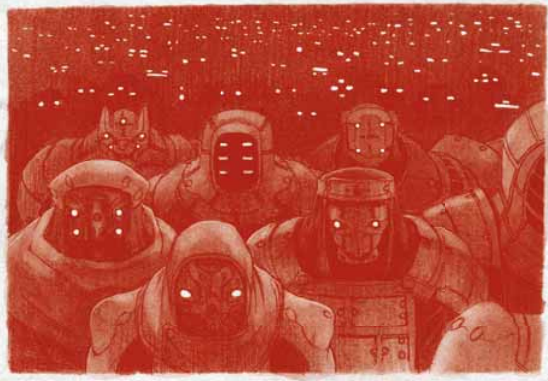
Looks trustworthy enough.
The Hyakki Swarm is lead by Three-Faced Koubei , a Heavy Assault Unit whose creator was just asking for something like this to happen when he created something with a total of eight souls, three of which are fully sentient.
Leader and top head of Three-Face is Koubei himself, melee weapons expert and practicioner of Kongohki-Fu. The right shoulder and arm are under control of Misuke , a former Annelidist martial artist (with her Wormcharm skill now being completely useless to her, for Kongohki don't have anything close to a Living Armour frame). The left shoulder and arm are the domain of Ayame , a former shuriken- and kunai-spamming Ninja expert.
While Three-Faced Koubei doesn't have any built-in weapons, he doesn't really need to considering the huge amount of actions he gets and mastery of every weapon he can get his hands on.
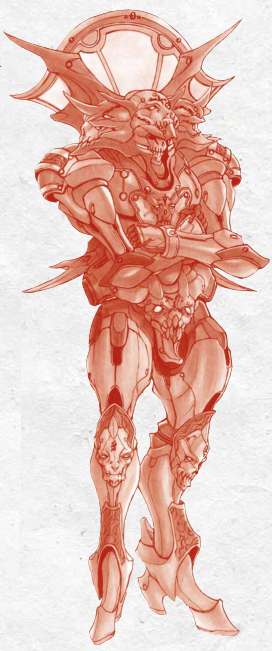
Crotchface seems almost self-concscious enough to contemplate on his life.
The Five from Kasumidani
A team of five Ninjas (most of them also dabbling into another archetype) who serve as potential ally/rival murder hobos to the PCs.
To further hammer down the murder hoboism, the Five have a simple outlook on life and will just help out anyone who pays them. Nobody knows why they need so much money or where it goes afterwards, but it seems to be connected with their "liege" they rarely speak about.
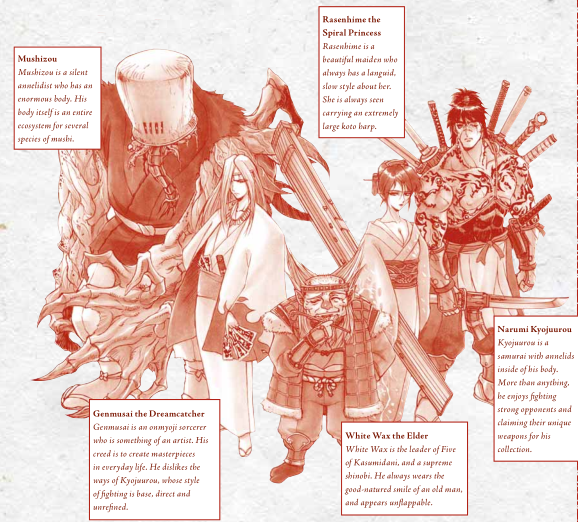
Looks like The Thing just wanted friends all along.
Next Time : Against the Tide - an example sandbox-y region of Tenra for PCs to mess around with.
Against the Tide
Original SA post Tenra Bansho Zero
Against the Tide
This chapter features an example sub-setting or "playset" for Tenra. It describes a specific region of Tenra in greater detail, but is by no means hardcoded into the greater setting. If the GM has better ideas for that particular region, he can just go for it.
The playset in question revolves around the province of Ryurin-shu on the Central Continent aka Yashima. More specifically, it is about a border conflict in the making after the geographical restructuring brought to you by the Phantom Star uncovered a big soulgem deposit in the ancient forest Naira-do that humans didn't give a damn about before.
Torigoe
Torigoe is the domain in which the forest Naira-do lies, and therefore the possible future battlefield over the soulgem mine. It used to be a pretty nice place to live in, but the Phantom Star hit it hard. Tsunamis and earthquakes ruined a good chunk of farmland while almost 1/4 of the entire area fell victim to the ocean.
Most of the Kitan family ruling over Torigoe and their advisors fell victim to either the Phantom Star or Golden Tiger , the Kongohki bodyguard who supposedly regained his memory during the calamity and went berserk (though whether he really did go crazy or is just a sacrifical lamb is open to GM fiat).
The last Kitan alive is the 17-year-old Kagetora , nephew of the former regent and woefully inexperienced. One of his first orders of business involved ordering his Armours to help clean up the farmland, showing that he was one of the few regents who actually gives a damn about the common folk. Unfortunately, his retainers felt that using their prized Armours and heirs for field work was dishonorable at best and insulting at worst.
Though Kagetora can count on the help of the 100 Falling Shadows Sect, a ninja clan that a sworn to protect the Kitan family, him being the only Kitan left has caused some of the ninja to fantasize about getting rid off Kagetora to free themselves of their century-old obligation to become freelancers.
Notable places in Torigoe include the sacred mountain of Ihara - or rather what's left of it, as it kinda slid off into the ocean, which wasn't a particularly good omen to say the least. The newly-created plateau is now home of an Annelidist community studying the rare Annelids that have started to appear here. They're also helping the nearby villages, earning them some much-needed anti-discrimmination points.
Of particular importance for PCs is The Copper Monkey , an inn owned by the omnyoji Last Call who only uses summoned Shikigami as staff - except for the bartender Ten Thousand Winters who is a Kugutsu. Also included in the building is a brothel and a yakuza gambling den, because why not.
As if Kegatora didn't have enough problems, the newly uncovered resources on his territory has awaken the interest of a much more powerful neighbor...
Hakusen
Hakusen is the realm of Buren , Master of the House of Thunder, the Dragon of Hakusen, one of Tenra's greatest warlords and overall magnificient bastard.
Buren always hated the Priesthood with a loving passion. So when the Phantom Star fell and the Priesthood split into two, he openly declared war on both. The much closer Northern Court (with their floating HQ only a 3 days ride away from Hakusen) immediately tried to curbstomp this insolent Lord, only for said lord to beat them and kick them off his land. Now he spends all day bolstering his already impressive forces, and Torigoe's soulgem are just want he needs.
Hakusen is unsurprisingly very militaristic, and very industrialized as Buren makes heavy use of kimenkyo war machines whose know-how he may or may not have gained from the Kimentoh. As a monument for his past victories and warning to future enemies, he has an big, ever-growing arch made out of the bones and destroyed Armours of his foes.
One of Buren's most interesting retainers is Radiant Deception an ex-miko that has no doubt played a big role in Buren's victory over the Northern Court.
Naira-do
One of the oldest forests in all of Tenra (in fact the name means "Eldest" in the Oni tongue). The reason Naira-do has been left completely untouched up until now is because humans met with heavy Ayakashi resistance when they tried to cut down the forest. The tengu clan of Ihara even warned humans about leaving the forest alone.
Humans, being humans, they naturally marched in with an army - never to be seen again. Soon after this, the entirety of the Central Continent fell prey to natural disasters and children gone missing, until a lone monk entered the forest and everything went back to normal. The monk - whose name was long forgotten by history - was never seen again, and the forest has since been declared sacred and a taboo by the Priesthood.
The forest is essentially run by fey, aka very powerful and human-like Ayakashi who each rule over their own little sub-domain and who share the forest with an Oni village and the Sharpened Leaves Ninja clan, who are bad enough dudes that the Ayakashi leave them be.
To keep anyone who is not a badass Ninja, the above mentioned monk as started a line of Forest Lords aka Keepers of Promise, who employ various human and non-human agents to divert humans away from the forest or - when necessary - kill them. The current Forest Lord is Yasuko , a monk/priestess/omnyoji who is sometimes plagued by visions (especially as of now) and stumbled into the forest during a trance (which seems to be the how a new Forest Lord os recruited). Her residence is The Restless Temple , which crawls through the forest on hundreds of marble arms and is home to various sorcerers and monks.
Yasuko's rival of sorts is Glass Rain Weeping , a humanoid henge Ayakashi who is actually responsible for the soulgem deposit getting discovered because he finds killing humans hilarious (in the great "fey are endlessly amused by humans" tradition).
Suma
This possible game-changer domain is ruled by Itokawa Yoichi . Too overweight for combat thanks to a gland defect, he studied warfare and became an accomplished general, playing all sorts of mind games with Buren over contested islands.
Appendix
To fill out this last post a little, let's take a look at the Appendix.
Media Resources
A list of various other pieces of media to get the right feeling and/or inspirations for TBZ. I don't know of this is from the original book or stuff from the translators.
The book recommends the entirety of Zatoichi, Ran and of course RoboGeisha, as welll as more ninja movies than you can throw a stick at.
The manga and anime list features obvious candidates like Blade of the Immortal, Fist of the North Star, Ninja Scroll, Samurai Champloo and Princess Mononoke.
For games, we have things like Tenchu, Way of the Samurai, Okami, Muramasa the Demon Blade and of course Sengoku Basara for general insanity. As the only thing with a Western setting, the book also recommends Valkyria Chronicles for its character-driven drama during a TBZ war campaign. Actually, playing Valkyria Chronicles with Kongohki and Armours would be rad. Or Kijin, so you end up purposely wounding your guys to mechanica them up later.
Other roleplaying games are also recommended, giving you typical candidates like Sengoku, Legend of the Five Rings, Blood and Honor, The Mountain Witch... and Hellas, which TBZ-grade crazy for Ancient Greek.
Player / GM advice
Just some general roleplaying advice and tips. Of particular note is that neither the translators nor the original writer of TBZ demand of you to be a 100% weeabo who knows all about Feudal Japan and honorifics. TBZ characters are supposed to stand out, so if you want to play as a redneck samurai who knows nothing about properly addressing other people, just go for it.
Though to help everyone out, there are lots of Japanese names for places and people, split into various charts depending on the person's standing.
Particularly useful are the charts to randomly create Kugutsu, Buddhist, Kongohki and Armour names, as those are quite poetic and nonsensical ("Vermillion Temple", "Ultimate Tiger", "Steel Demon", to name some rolled examples). You can't roll up Moon Moon, but you can end up with Heavenly Heaven. Or Spider Ox.
And thus ends this series of posts. TBZ is pretty rad, and I can't wait for the upcoming supplements, both the official one and the Persona-esque setting.
Next Time : While I'm at translated Japanese RPG stuff... does anyone wanna hear about Double Cross supplements? Let's make it a DX-mas!
(Warning: I'm spending the holidays with my family, where I am notoriously unproductive. I'll probably not be able to finish this this year. Or start it, for that matter.)